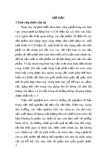BỘ GIÁO DỤC VÀ ĐÀO TẠO TRƢỜNG ĐẠI HỌC SƢ PHẠM TP. HỒ CHÍ MINH BÁO CÁO TỔNG KẾT ĐỀ TÀI KH&CN CẤP BỘ SỰ TỒN TẠI VÀ NGHIỆM TỐI ƢU CỦA MỘT SỐ BÀI TOÁN TRONG GIẢI TÍCH PHI TUYẾN : B2005.23.68 MÃ SỐ CHỦ NHIỆM ĐỀ TÀI : PGS.TS. LÊ HOÀN HÓA
TP.HCM, NĂM 2007
BỘ GIÁO DỤC VÀ ĐÀO TẠO TRƢỜNG ĐẠI HỌC SƢ PHẠM TP. HỒ CHÍ MINH
BÁO CÁO TỔNG KẾT ĐỀ TÀI KH&CN CÁP BỘ
SỰ TỒN TẠI VÀ NGHIỆM TỐI ƢU CỦA MỘT SỐ BÀI TOÁN TRONG GIẢI TÍCH PHI TUYẾN
MÃ SỐ CHỦ NHIỆM ĐỀ TÀI : B2005.23.68 : PGS.TS. LÊ HOÀN HÓA
TP.HCM, NĂM 2007
DANH SÁCH NHỮNG NGƢỜI THAM GIA THỰC HIỆN
PGS. TS. Nguyễn Bích Huy PGS.TS. Nguyễn Định
---o0o---
TÓM TẮT KẾT QUẢ NGHIÊN CỨU ĐỀ TÀI
KHOA HỌC VÀ CÔNG NGHỆ CẤP BỘ Tên đề tài:
Sự tồn tại nghiệm và nghiệm tối ƣu
của một số bài toán trong giải tích phi tuyến
Mã số : B2005.23.68
Chủ nhiệm đề tài : PGS.TS. Lê Hoàn Háo, Điện thoại (08)75 22 625
Cơ quan chủ trì đề tài : Trƣờng Đại học Sƣ phạm Tp.HCM
Cơ quan và cá nhân phối hợp thực hiện :
PGS.TS. Nguyễn Bích Huy
PGS.TS. Nguyễn Định
Thời gian thực hiện: 4/2005 đến 4/2006
1. Mục tiêu : đề tài nhăm 3 mục tiêu chính sau đây
- Nghiên cứu sự tồn tại nghiệm và cấu trúc của tập nghiệm cho phƣơng trình tích phân
và tập nghiệm yếu của phƣơng trình sóng nửa tuyến tính
- Nghiên cứu sự tồn tại nghiệm cho lớp bài toán Cauchy bậc hai trong thang các
không gian Banach.
- Thiết lập các điều kiện tối ƣu dạng Karush - Kuhn - Tucker, các điều kiện điểm yên
ngựa, đối ngẫu và ổn định cho các bài toán tối ƣu lồi trong không gian vector tôpô lồi địa
phƣơng Hausdorff.
2. Nội dung chính:
- Chƣơng 1. Tính compact và liên thông của tập nghiệm
- Chƣơng 2. Bài toán Cauchy bậc hai trong thang các không gian Banach và áp dụng
cho phƣơng trình Kirchhoff.
- Chƣơng 3. Các điêu kiện chính qui dạng Farkas trong các bài toán tối ƣu lồi vô hạn.
3. Kết quả chính đạt đƣợc (khoa học, ứng dụng, đào tạo, kinh tế - xã hội):
- Kết quả về khoa học : 3 bài báo, trong đó hai bài đã công bố trong tạp chí toán học
nƣớc ngoài năm 2004 - 2005 và một bài công bố năm 2006 trong Demonstrator số 36.
1
- Kết quả đào tạo : Những nội dung trên đã đƣợc chúng tôi nghiên cứu trong một thời
gian dài, các két quả từng bƣớc đƣợc triền khai trong các luận văn Thạc sĩ và luận án Tiến sĩ.
Đã bảo vệ thành công 5 Thạc sĩ (10 - 2005)
1) Trần Trí Dũng, ngƣời hƣớng dẫn PGS.TS. Lê Hoàn Hoa. Đề tài: Phƣơng trình vi
phân đôi sô lệch trong không gian Banach - Công thức biên thiên hằng số và dáng điệu tiệm
cận.
2) Nguyễn Thị Cúc Hƣơng, ngƣời hƣớng dẫn PGS.TS. Lê Hoàn Hoa. Đề tài : Tính
dao động, tính không dao động và tính ổn định cho phƣơng trình vi phân trung hòa đối số
lệch
3) Lê Trần Tố Loan, ngƣời hƣớng dẫn PGS.TS. Lê Hoàn Hoa. Đề tài : Phƣơng trình
vi tích phân phi tuyến loại Hyperbolic.
4) Nguyễn Thanh Hà, ngƣời hƣớng dẫn PGS.TS. Nguyễn Bích Huy. Đề tài : Bài toán
Cauchy trong thang các không gian Banach.
5) Lê Thị Tuyết Nhung, ngƣời hƣớng dẫn PGS.TS. Nguyễn Bích Huy. Đề tài : vector
riêng dƣơng của ánh xạ tuyến tính.
Danh sách luận văn thạc sĩ, luận án tiến sĩ hoàn thành năm 2007
1) Trần Thị Thu Nguyệt, ngƣời hƣớng dẫn PGS.TS. Lê Hoàn Hóa. Đề tài : Một vài
cách tính bậc tôpô và ứng dụng vào bài toán phân nhảnh toàn cục của bất đẳng thức biến
phân.
2) Phan Kim Khánh, ngƣời hƣớng dẫn PGS.TS. Lê Hoàn Hóa. Đề tài . Tính compắc,
liên thông của tập nghiệm một số phƣơng trình vi, tích phân.
3) Nguyễn Đình Tƣờng Long, ngƣời hƣớng dẫn PGS.TS. Lê Hoàn Hóa. Đề tài : Giá
trị ban đâu của nghiệm bị chặn của phƣơng trình vi phân tuyên tính với hàm ràng buộc tuần
hoàn.
4) Lê Thị Phƣơng Ngọc (Tiến sĩ), Ngƣời hƣớng dẫn PGS.TS. Lê Hoàn Hóa. Đề tài:
Ƣng dụng phƣơng pháp diêm bát động trong sự tôn tại nghiệm của phƣơng trình.
Nguyễn Khải Hoàn, ngƣời hƣớng dẫn PGS.TS. Nguyễn Bích Huy. Đề tài : Một sô
nghiên cứu vê phƣơng trình logistic.
5) Trần Thị Bích Thu, ngƣời hƣớng dẫn PGS.TS. Nguyễn Bích Huy. Đề tài: Một số
lớp bài toán Cauchy trong thang các không gian Banach.
2
SUMMARY Project Title:
The existence of solution and optimality solution of some problems
in non-linear Analysis
Code number : B2005.23.68
Coordinator : associate professor Doctor Lê Hoàn Hóa
Implementing Institution : hochiminhcity university of education
Cooperating Institution(s) : associate professor doctor Nguyen Bich Huy, associate
professor doctor Nguyễn Đinh.
Duration : from May 2005 to June 2006
1. Objectives
- Study the existence and the structure of the solution set of integral equations and
weak solution set of semi linear wave equations
- Study second-order Cauchy problem in a scale of Banach spaces
- Provide Karush - Kuhn - Tucker and saddle point optimality condition , duality and
stability for consistent convex optimization problem posed in locally convex topological
vector spaces
2. Main contents
- The connectivity and compactness of solution sets.
- A second-order Cauchy problem in a scale of Banach spaces and applications to
Kirchhoff equations.
- New Farkas-type constraint qualifications in convex infinite programming.
3. Results obtained
- Three were published in foreign mathematical Bulletins
- The result of these three papers were used in five Master-degree thesis.
3
MỤC LỤC
TÓM TẮT KẾT QUẢ NGHIÊN CỨU ĐỀ TÀI ....................................................................... 1
CHƢƠNG 1 : TÍNH LIÊN THÔNG VÀ COMPAC CỦA TẬP NGHIỆM .............................. 5
The connectivity and compactness of solution sets ............................................................... 8
CHƢƠNG 2: BÀI TOÁN CAUCHY BẬC HAI TRONG THANG CÁC KHÔNG GIAN BANACH VÀ ÁP DỤNG CHO PHƢƠNG TRÌNH KIRCHHOFF ....................................... 22
A second-order Cauchv problem in a scale of Banach spaces and application to Kirchhoff equations ........................................................................................................... 24
CHƢƠNG 3: CÁC ĐIỀU KIỆN CHÍNH QUY DẠNG FARKAS TRONG CÁC BÀI TOÁN TỐI ƢU LỒI VÔ HẠN ............................................................................................................ 37
New Farkas –Type constraint qualifications in convex infinite programming .....Error! Bookmark not defined.
THUYẾT MINH ĐỀ TÀI ........................................................................................................ 65
4
CHƢƠNG 1 : TÍNH LIÊN THÔNG VÀ COMPAC CỦA TẬP NGHIỆM
Nội dung: Chúng tôi chứng minh tập nghiệm của phƣơng trình tích phân sau là tập
khác rỗng, compắc và liên thông:
(1)
và tính compắc, liên thông của tập nghiệm yếu cho phƣơng trình sóng nửa tuyến tính với các điều kiện biên ban đầu :
(2)
trong đó uo, u1, f là hàm cho trƣớc, hàm chƣa biết u (x, t) và giá trị biên chƣa biết P(t) thỏa mãn phƣơng trình tích phân phi tuyến sau :
trong đó g,H,k cho trƣớc.
Công cụ chính là lý thuyết bậc tôpô của trƣờng compắc. 1. Tổng quan: Bên cạnh bài toán về sự tồn tại nghiệm, số nghiệm hoặc cấu trúc của tập nghiệm cho các phƣơng trình vi phân, phƣơng trình tích phân, phƣơng trình đạo hàm riêng... đã đƣợc nghiên cứu. Nhiều tác giả nghiên cứu về tính liên thông của tập nghiệm. Thí dụ một áp dụng là định lý: Nếu bài toán giá trị biên hỗn hợp cho phƣơng trình Parabolic nửa tuyến tính có hai nghiệm phân biệt thì tập nghiệm là vô hạn không đếm đƣợc. Theo [4], định lý khởi đầu là ống nghiệm có mặt cắt là tập liên thông đƣợc chứng minh bởi Kneser. Tính liên thông của tập nghiệm đƣợc thiết lập đầu tiên bởi Fukuhara. Các định lý này đƣợc nhiều tác giả mở rộng cho lớp phƣơng trình vi phân tổng quát. Từ các định lý cơ bản trên, chúng tôi nghiên cứu cấu trúc của tập nghiệm cho phƣơng trình (1) và bài toán (2). Sự tồn tại nghiệm của (1) - (2) đƣợc thiết lập trong ([2],[6]). Trên cơ sở các kết quả của ([2],[6]), sử dụng lý thuyết bậc tôpô cho trƣờng compắc và định lý về sự sắp xỉ lipsit địa phƣơng của ánh xạ liên tục, chúng tôi chứng minh tập nghiệm của [1] và tập nghiệm yếu của [2] khác rỗng, compắc, liên thông.
), E) là không gian 2. Định lý Ì về tính compắc liên thông của tập nghiệm. Cho E là không gian Banach với chuẩn ||. Đặt X0 = C([0, ) vào Evới họ nửa chuẩn:
với mọi n
Frechet các hàm liên tục từ [0,
5
f : [0, ) x E E liên tục với tính chất : Với mỗi n , kn > 0 sao cho
)2 x E → E hoàn toàn liên tục sao cho : Và mêtric Khảo sát phƣơng trình tích phân: (I) Trong đó f, g thỏa mãn các điều kiện : (I1) (I2) g : [0, g(t,.,.) : I x A E liên tục đều đối với t trong khoảng bị chặn, với mọi tập bị ) và tập bị chặn A E chặn I [0,
đều đối với (t, s) [0, )2. (I3)
Định lý 1: Giả sử f và g thỏa mãn (I1)-(I3) theo thứ tự. Khi đó tập nghiệm của phƣơng trình (I) trên [0, ) là tập khác rỗng, compắc, liên thông.
Để chứng minh định lý 1 ta cần đến định lý điểm bất động loại KrasuoselsKii trong không gian lồi địa phƣơng [2], định lý về tính compắc liên thông của tập nghiệm [4, p. 312, Định lý 48.2], định lý về sự xấp xỉ lipsit địa phƣơng của ánh xạ liên tục [1] ([1], chƣơng 2, trang 53), định lý về mở rộng liên tục (xem [7, chƣơng 2, trang 49]).
3. Định lý 2 về tính compắc, liên thông của tập nghiệm yếu. Cho = (0, 1), QT = (o, T), T > 0, LP = LP () , H1 = H1 (), H2 = H2 () trong đó H1, H2 là không gian Sobolev trên .
Chuẩn trên L2 là ||||, <.,.> là tích vô hƣớng trên L2 hay cặp của phiếm hàm tuyến tính liên tục với phần tử của không gian, chuẩn trên không gian Banach X ghi là |||| , LP(0,T; X), là không gian Banach các hàm số thực u : (0,T) X đo đƣợc, sao cho:
Khi đó V là không gian con đóng của H1 và trên và ||V||V = √ là
hai chuẩn tƣơng đƣơng.
Các giả thiết sau đây đƣợc lập ([6])
6
(A4) Hàm H C1 ( ) thỏa mãn f (0, 0) = 0 và tồn tại hằng số ho > 0 sao cho:
Hàm số f : 2 thỏa mãn f (0, 0) = 0 và các điều kiện sau :
Tồn tại hai hằng số , (0, 1] và hai hàm số B1, B2 : + + liên tục và thỏa mãn :
Định lý 2 : (A1) - (A4) và (F1) thỏa mãn. Giả sử thêm f liên tục . Khi đó, với mọi T >
0, tập hợp nghiệm yếu (u, P) của bài toán (2) sao cho
u L (0, T, v), u1 L (0, T, L2), ut (0, t) L2 (0, T,), P(t) H1 (0, t)
là tập khác rỗng, compắc và liên thông.
Để chứng minh định lý 2 ta cần định lý về sự tồn tại duy nhất nghiệm cho trƣờng
compắc.
Các kết quả trong chƣơng 1 sẽ đƣợc công bố trong tạp chí Demonstrato số 36 năm
2006 (đính kèm toàn văn bài báo : The connectivity and compactness of solution sets)
7
The connectivity and compactness of solution sets Le Hoan Hoaa, Le Thi Phuong Ngocb
a Department of Mathematics, Ho Chi Minh City University of Education. 280 An Duong Vuong Sir., Dist. 5, Ho Chi Minh City, Viet Nam. bNhatrang Educational College, 01 Nguyen Chanh Str., Nha Trang City, Viet Nam. E-mail: phuongngoccdsp@dng.vnn.vn Abstract : In this paper, we show that the solution set of the following equation is
nonempty, compact and connected
and we also consider the above properties for the weak solution set of the following
semilinear wave equation with the initial - boundary
where u0, u1, f are five functions, the unknown function u(x, t) and the unknown boundary
value P(t) satisfy the following nonlinear integral equation
where g, H, k are given functions.
The main tool is the topological degree theory of compact vector fields.
Keywords : Topological degree; Compact vector fields, Relatively compact set.
1. Introduction.
Besides the existence problem for solution, the number of solutions or the structure of
the solution set for many equations such as differential equations, integral equations, partial
differential equations, ... have been considered by many mathematicians. Many authors have
considered the connectivity property of the solution set. A paradigmatic application is the
following theorem: if a mixed boundary value problem for a quasilinear parabolic equation
has two different solutions, then there must be a continuum of solutions.
According to [4], the first theorem stating that the solution funnel has connected
sections was stated by A. Kneser. Connectedness of the solution set was first established by
M. Fukuhara. These theorems have been extended by various authors to more general classes
of differential equations. There are three generalizations which are particularly important (it
is well known in [4], Ch.6 -316 with the references therein).
8
The paper consists of three sections and the main results of the paper will be
Let E be a real Banach space with norm | | be the Frechet
pn(x) = sup {|x(t)|, t [0, n]}, for each n N,
(1) x(t) = ∫ ( ) ∫ ( )
f : [0, ) x E E is continuous with the property : for each n N, kn > 0 such that |f(t, x) - f(t, y)| kn |x - y|, x, y E, t [0, n], g : [0, )2 x E E is completely continuous such that g(t, ., .): I x A E is
On the basis of the above theorems, we consider the structure of the solution sets of the above equations (1) and (2), where all given functions satisfying conditions to be specified later. The existence of solutions of equations (l)-(2) was established in ([2 ], [6]). Based on the results of ([2], [6]) with applying the topological degree theory of compact vector fields and the theorems about a continuous. mapping of Functional Analysis, the paper proves that the solution set of the equation (1) and the weak solution set of the equation (2) are nonempty, compact and connected. Here, the equations (1), (2) are only considered on the domain which are chosen as that in the following proofs. presented in the sections 2 and 3. 2. The first theorem about the connectivity and compactness of the solution set. space of all continuous functions on [0, ) to E with the family of seminorms and the metric d(x, y) = ∑ Consider the integral equation : where f, g satisfy the conditions as follows : (I1) (I2) continuous uniformly with respect to t in any bounded interval, for any bounded I [0, ) and any bounded A E. (I3) | | | | | | uniformly with respect to (t, s) [0, )2. Theorem 1. Suppose that f and g satisfy (I1) - (I3) respectively. Then the solution set of equation (1) on [0, ) is nonempty, compact and connected. In order to prove the theorem 1, let us recall the following theorems. The Fixed point theorem of Krassnosel'skii type in locally convex space. This theoremused the condition as follows. Condition (A). ([2]) Let X be a locally convex topological vector space and let P be a separating family of seminorms on X. Let D be a subset of X and let U : D X. For any a X, define Ua : D X by Ua(x) = U(x) + a. The operator U: D X is said to satisfy condition (A) on a subset Q of X if : (A.l) For any a , Ua(D) D.
9
implies
(A.2) For any aQ and pP there exists ka Z, with the property : for any > 0,
)
(
{ ( } { } { }
where there exist r N and > 0 such that for x, yD with ) ,
Theorem B1. ([2]) Let X be a sequentially complete locally convex space with a separating family of seminorms P. Let U and C be operators on X such that
)
(i) U satisfies condition (A) on X, (ii) For any p P, there exists k > 0 (depending on p) such that p(U(x) - U(y)) < k p(x-y), .
(iii) There exists x0 X with the property : for any p P, there exist r N and [0,1) (r and depending on p) such that (
(iv) C is completely continuous, p(C(A)) whenever p(A) , for A X (v) ( ) .
Then U + C has a fixed point. Remark 1. ([2]) Let X be a locally convex space with a separating family of seminorms P. Let D be a sequentially complete subset of X. Let U be a uniformly continuous operator on D and U satisfies condition (A) on a subset of X. Then the operator (I-U)-1 is well defined and continuous on . Furthermore, if in condition (A) can be chosen independent of a then the operator (I-U)-1 is uniformly continuous in .
Remark 2. From the proof of theorem Bi ([2]) we have : In case family of seminorms P is Finite, there exists a bounded open convex subset D of X with boundary D and closure ̅ such that (I-U)-1C( ̅) D and (I - U)-1 C has a fixed point in ̅ (not in D) which is precisely a Fixed point of U + C in ̅ (not in D).
Theorem B2. ([4]) Let (E, |.|) be a real Banach space, D be a bounded open set of E with boundary D and closure ̅ and T: ̅ E be a compact operator. Assume that T satisfies the conditions as follows :
(i) T has no fixed points on D and deg (I-T, D, 0) 0. (ii) For each > 0, there is a compact operator T such that | | , for all x ̅ and such that for each h with |h| < the equation x = T(x)+ h has at most one solution in ̅. Then the set of fixed points of T is nonempty, compact and connected. The proof of theorem B2 can be found in [4, p. 312, theorem 48.2].
Theorem B3. ([ 1 ]) Let E, F be Banach space, D be an open subset of E andf: D F be continuous. Then for each > 0, there is a mapping f : D F that is locally Lipschitz such that
| | , for all x D
and f(D) cof(D), where cof(D) is the convex hull of f(D)
10
The proof of theorem B3 can be found in [1, ch 2, p. 53]. Theorem B4. (Tietze (1915), Dugundji (1951)) ( see [7, ch. 2, p.49]) Let M be a closed nonempty subset of the metric space X, Y be the normed space and f: M Y be a continuous operator. Then there exists a continuous mapping g : X Y such that :
(i) g(X) co(f(M)), where cof(M) is the convex hull of f(M). (ii) g(x) = f[x) for all x M. And we also recall the following proposition, see [3, proposition 1]. Proposition B5. A set S in X0 is relatively compact if and only if for each n N, S is equicontinuous in [0, n] and the set {x (t)/ x S, t [0, n]} is relatively compact in E.
The proof of Theorem 1. Step l. We prove that for each n N, the solution set of (1) on [0, n] is nonempty, compact and connected.
Proof. For each n N, let Xn = C([0, n], E) the Banach space of all continuous functions on [0, n] to E with the norm ||x||n = sup{|x(t)|, t [0, n]}. Let U, C : Xn Xn be defined as follows:
Then, we can prove in a similar manner in [2, lemma 2, 3], that : for all z Xn
And C is completely continuous operator on Xn satisfying This implies that U and C satisfy the conditions of theorem B1, hence by that theorem and remarks 1; 2, (I-U)-1 is well defined and is uniformly continuous on Xn. Further there exists a bounded open convex subset D in Xn with boundary D and closure ̅ such that (I-U)-1C( ̅) D and (I-U)-1 C has a fixed point in ̅ (but it is not in D), clearly ̅ is bounded closed convex subset of Xn.
T = (I-U)-1C.
I - T = (I - U)-1(I-U-C),
Put (2.5) It is clear that (2.6) so fixed points set of T in ̅ is also fixed points set of U+C which is precisely solutions set of equation (1) with the domain is ̅. If we can prove the set of fixed points of T in ̅ is nonempty, compact and connected then the proof of step 1 completes, here we note that the equation (1) is only considered on the domain ̅
11
Since C is completely continuous operator on Xn, we have T is completely continuous operator on Xn. As above, T has no fixed point in D. Further T( ̅) D and D convex , so we have (2.7) deg (I-T, D, 0) = 1.
> 0, since (I – U)-1 is uniformly continuous on Xn, there exists > 0 such that (2.8) ||x-y||n < ||(I - U)-1(x) - (I - U)-1(y)||n < , Let (2.9) K = {x(s) / s [0, n], x ̅
(2.10) Then K is bounded in E. So, ̅ is bounded in E, where ̅ is the closure of K. We note that, for all x ̅ and s [0, n], x(s) ̅ . By the theorem B4, there exists a continuous mapping g* which is the extension of g / [0, n]2x ̅ on [0, n]2xE, here g / A denotes the restriction of g on A, such that: g*([0, n)2xE) cog([0. n]2x ̅).
By the theorem B3, there exists g that is a locally lipschitz operator on [0, n]2 x E such that for all s, t [0, n], and for all x E : (2.11) |g(t, s, x)-g*(t, s, x)| < / 2n, and (2.12)
g[0, n]2 x E) cog*([0,n]2 x E) cog([0, n]2 x ̅ ). Since g is completely continuous, g ([0, n]2 x ̅) is relatively compact. It follows that g ([0, n]2 x E) is relatively compact. We obtain g is completely continuous. Put C : Xn Xn as follows and put Then (2.15) T is completely continuous.
It follows from (2.2), (2.11), 92.13) that for all t [0, n], for all x ̅ So, Thus, by (2.8)
It also mean that For each h with ||h||n < , we prove that the following eqation has at most one solution on ̅ Suppose that x, y are the solutions of the equation (2.19) We shall prove that
12
It is easy to see that :
(2.21) x(0) = y(0) = h(0).
Let
b = max { [0, n] / x(t) = y (t), t [0, ]}.
(2.22) Clearly, b 0. We suppose by contradiction that b < n. Since g is locally lipschitzian, there exists r > 0 such that g is lipschitz with lipschitz constant m in [0, n]2 x Br , where Br= {z E/ | z - x(b) | < r}. Since x, y are continuous, there is a > 0 such that b + n and x(s), y(s) Br for all s [b, b + ]. We note that [b, b + ] [0, n]. For all t [b, b + ], we have :
Since x{b) = y(b), this inequality implies that x(t) = y(t) for all / e [b, b + ]. It follows that
(2.23) x(t) = y(t) for all t [0, b + ].
From (2.22) and (2.23), we get a contradiction. Thus (2.20) holds.
Combining (2.7), (2.15), (2.18), (2.20) and applying theorem B2, the step 1 is proved.
Step 2. We prove that the solution set of (1) on [0, ) is nonempty, compact and connected.
Proof. First, we note that if x(t) is a solution of (1) on [0, ) then x|[0, n] (t) is a solution of (1) on [0, n], for all n N. Otherwise, for all n N, for each solution xn of (1) on [0, n], there exists a solution x* of (1) on [0, ) such that x *|[0, „] = x„. In other words, xn is expanded on [0, ). Indeed, we consider the equation
(2.24) x(t) = xn(n) + ∫ ( ) ∫ ( )
Applying the theorem B1, with the proof is We define x* : [0, ) E by
x {
Clearly, x*(t) is a solution of (1) on [0, ) and | = xn. Let S be the solution set of (1) on [0, ). By [2, the theorem 5], S is nonempty.
Now, we prove S is compact and connected. Here, we only consider the set S such that for each n N, the set Sn = { x|[0 n], x S} ̅ with ̅ is defined in step 1. By step 1, Sn is nonempty, compact and connected on Xn = C([0, n], E). Then, by proposition B5, we have S is relatively compact in X0 =C ([0, ), E).
13
={ x0| , x Sa},
.
={ x0| , x Sb} are nonempty, disjointed and S =
and
are closed. Indeed, which converges to x0, as k . Then, there exists a sequence
} of
| = xk. Since Sa is compact, there exists a subsequence { | y| , as i .
converges to y in Sa. This implies that
are
. Then
| = . converges to x0 that x0 = y|
is also closed.
Furthermore S is closed. Indeed, let {xk} be a sequence in S which converges to x0 , as k , then xk | x0| . From xk | Sn and Sn is compact we obtain that x0 | S. Hence, x0 S. Thus S is compact. We prove that S is connected. Suppose, to get a contradiction, that S is not connected. Then there exists two sets Sa and Sb which are nonempty, compact and disjointed such that S = Sa Sb. Put It is clear that and On the other hand, Let {xk} be a sequence in {x*k} in Sa such that } such that { It follows from y Sa and closed. Similarly, This implies that Sn is not connected which gives the contradiction. The step 2 is proved. □ The theorem 1 is proved completely. ■
3. The second theorem about the connectivity and compactness of the weak solution set. Let = (0, 1), QT, = x (0, T), T > 0, LP = LP (), Hl = Hl (), H2 = H2 (), where
H1, H2 are the usual Sobolev spaces on .
The norm in L2 is denoted by ||.|| < . , . > denotes the scalar product in L2 or pair of dual scalar product of continuous linear functional with an element of a function space, the norm of a Banach space X is denoted by ||.|| x. LP (0, T; X), 1 , denotes the Banach space of the real function u : (0, T) X measurable, such that
and
put
Then V is a closed subspace of Hl and on V, || || and ||v||V = √ are two equivalent norms. The notations are used : u’ = u1 = u / t, u” = u11 = 2 u / r2. The following assumptions are made ([6]) :
14
(A4) The function H C1 (R) satisfies H(0) = 0 and there exists a constant h0 > 0
̂ ∫
of the equations :
such that The function f : R2 R satisfies f (0, 0) = 0 and the following conditions : (F1) ( f (u, v) – f (u, ̃ )) (v - ̃ ) 0, , v, ̃ R; There are two constant a , (0, 1] and two functions B1, B2: R+ R+ continuous and satisfying : Theorem 2. Let (A1) - (A4) and (F1) … hold. Suppose in addition that f is continuous. Then, for every T > 0, the set of the weak solutions (u, P) of problem (2) such that is nonempty, compact and connected. In order to prove the theorem2 , for convenience, let us recall the following theorem ([6]) and the main steps in the proof of this theorem. The notations which, are used in this theorem are given as above. Theorem C ([6]) (The existence and uniqueness of weak solution) Let (A1) - (A4) and (F1) -(F3) hold. Then, for every T > 0, there exists a weak solution (u, P) of problem (2) such that Furthermore, if = 1 in (F3) and the function H, B2 satisfying, in addition, Then the solution is unique. The proof of theorem C ([6]) consists of several steps. Step J. (The Galerkin approximation) Seeking the solution (um(t), Pm(t)) with ∑
15
c = Uc
For every Put Choosing M > 0 and Then, S is a closed convex and bounded subset of the Banach space Y = C1([0, Tm]; Rm) and the operator U : S Y has the properties : U is continuous on S, US S, ̅̅̅̅ is compact in Y. Applying the Schauder fixed point theorem, U has a fixed point c = (c1, c2,… cm) S such that c = Uc. This implies that the system (C.1)-(C.3) has a solution (um(t), Pm(t)) with um(t) = ∑ Step 2. A priori estimates . These estimates allow one to take Tm = T for all m. Step 3. Passing to limit. There exists a subsequence of sequence {um, Pm} (it was chosen two times), still denoted by {um, Pm}, such that : um u in L(0, T; V) weak* , um u strongly in L2(Qr), u'm u' in L (0, T; L2) weak*,
This system was rewritten in from which is equivalent to the system (C.4) where c = (c1, c2, …, cm), Uc = ((Uc)1, (Uc)2,…, (Uc)m), ( the indexm was omit )
16
Then (u, P) is the weak solution of the problem. Step 4. Uniqueness of the solution. The proof of the theorem 2. The proof consists of the following steps . Step 1. The set of fixed points c of the operator U : ̅ Y is nonempty, compact, and connected. Where ̅ = {c C1([0, Tm]; Rm) / ||c||1 M) is the closure of the open convex and bounded subset S = {c C1([0, Tm]; Rm) / ||c||1 < M), with M > 0, Tm > 0 will be chosen later. Proof. We have f : R2 R is continuous, so for all > 0, by the theorem B3, there exists a mapping f : R2 R is locally Lipschitz approximation of f such that (3.1) |f(u, v) - f(u, v)| < / , R,
U : [0, 1]x ̅ Y (,c) U(,c) is denoted by Uc where > 0 is chosen in order that / is small enough. Clearly, f is continuous. First, we define the followings operators. Let U : ̅ Y be defined as follows : Let be defined as follows :
17
(3.5)
Where (Vc)j(t) is given as (C.6) Next, we put
And choosing M > 0 and Tm > 0 such that : M > 2||G||1
Then, from the proof of step1 in theorem, we have the following operators are compact Furthermore, since ||Uc||1 < M, ||Uc||1 < M, [0, 1], we have the operators U, U (U = U when = 1) have a fixed point c S but c S. This shows that
(3.7) 0 (I - U)S
And, we also have an estimation as in [6] of the term ||Vc - Vd||0, for all c ̅ and
radius > 0 And we can prove in a similar manner as in [6] that U : ̅ Y is compact, with the following notes. Namely/ When we replace f by f in the definition of operator U : ̅ Y, we obtain the respective operator U : ̅ Y. The mapping f is continuous, so we can put (M, T) as above, and with choosing M, Tm as that, we have the operator U maps ̅ into itself. for all d belongs to a neighbourhood, with radius > 0 small enough, of c in ̅ Y. Indeed, Since f is locally Lipschitz, for all c in ̅, there exits the neighbourhoods with the same in R2, for all t [0, Tm], such that f is
lipschitz on these neighbourhoods. So,
18
for all t [0, Tm],
If we choose > 0 in order to be long to the above neighbourhoods, respectively, then there exists L > 0, such that :
It follows that there exists a constant KM > 0 such that
Thus, similarly in [6], we also obtain that U : ̅ Y is continuous. We also have that U( ̅) is bounded and equicontinuous with respect to the norm ||.||1
of the space Y. Therefore, U is compact. Furthermore, we have :
is large enough.
Combine with (3.1), we have This implies that And thus (3.8)
Now, we prove that for each h with ||h||1 < , the equation has at most one solution on ̅ as follows If are two solutions of the equation (3.9), then
Are two solutions of the following system ;
19
(t) on [0, Tm], since the family ( j) is linearly
(t) =
Where Clearly, c = d if only if independent
So, we prove
(b) R, there exists a
(b) =
(t) are continuous on [0, Tm], so they are continuous at b. Then,
(t),
(t) belong to B, for all t [b,
(t) and
(t), for all t [b, b + ].
(t) =
(t) on [0, Tm].
(t) =
We have
Put We shall prove b = Tm. Suppose in contradiction that b < Tm. Since f : R2 R is locally Lipschitz, with neighbourhood B of u1(b) which has radius r > 0 and there exists L' > 0 such that We also have with r > 0 as above, there exists > 0 such that b + ]. We obtain From this property, we can prove in a similar manner in step 4,([6]), that This gives a contradiction with choosing b. Thus, Finally, we only prove that (3.10) deg(I-U, S, 0) 0.
deg(I-U1, S, 0) = deg (I-U0, S, 0), This is proved as follows. The family of the compact operators U satifies the condition (3.7), so applying the homotopy invariance property of the degree, we obtain deg(I-U - U, S, 0) does not depend on . It implies that : where I - U1 = I - U and U0 is the constant mapping, since we have : for all c ̅ ,
is continuous. Thus deg(I-U, S, 0) = deg(I- U0, S, 0) = 1. We have (3.10) holds. Combining (3.6) - (3.10) and applying the theorem B2, stepl is proved. Step 2. The set of the solutions (um, Pm), which exist from the above proof, is nonempty, compact and connected. There is this result since the mapping in which for each c = (cm1, cm2, ... , cmm) is corresponding with um such that ∑
20
Step 3. The set of the weak solutions (u, P) which exist thanks to passing the solutions (um,
Pm) to limmit is nonempty, compact and connected.
We also have this result since the mapping in which for each (um, Pm) is corresponding with
the weak solution (u, P) is continuous. □
The theorem 2 is proved completely. ■
References
[1] K. Deimling, Nonlinear functional analysis. Springer, NewYork, 1985.
[2] L. H. Hoa - K. Schmitt, Fixed point Theorem of Krassnosel'skii type in locally
covex spaces and applications to integral equations, Results in Math. 28 (1994), 290 - 314.
[3] L. H. Hoa - K. Schmitt, Periodic solutions of functional differential equations of
retarded and neutral types in Banach spaces. Boundary Value Problems for Functional
Differential Equations, Editor Jonhny Henderson, World Scientific (1995), 177 - 185.
[4] M.A. Krasnosel'skii P.P. Zabreiko, Geometrical Methods of Nonlinear Analysis,
Springer-Verlag Berlin Heidelberg New York Tokyo, 1984.
[5] Nguyen Thanh Long - Alain Pham Ngoc Dinh, A semilinear wave equation
associated with a linear differential with Cauchy data. Nonlinear Analysis, Theory, Methods
& Applications, Vol. 24 (1995), pp. 1261-1279.
[6] Nguyen Thanh Long - Tran Minh Thuyet, A semilinear wave equation
associatedwith a nonlinear integral equation, Demonstratio Mathematica, Vol.XXXVI, No 4,
2003.
[7] Eberhard Zeidler, Nonlinear Functional Analysis and its Applications, Springer-
Verlag New York Berlin Heidelberg Tokyo, Part I.
21
CHƢƠNG 2: BÀI TOÁN CAUCHY BẬC HAI TRONG THANG CÁC KHÔNG GIAN BANACH VÀ ÁP DỤNG CHO PHƢƠNG TRÌNH KIRCHHOFF
Các phƣơng trình vi phân trong thang các không gian Banach đƣợc ứng dụng nhiều
trong Cơ học, Vật lý, Phƣơng trình đạo hàm riêng... để nghiên cứu các bài toán chứa kỳ dị.
Sự tồn tại và duy nhất nghiệm của các phƣơng trình cấp 1 với điều kiện Lipschitz đƣợc
nghiên cứu bởi Ovsjannikov, Trenes, Nirenberg, Nishida, Tuschke,... Một lớp phƣơng trình
cấp 1 thỏa điều kiện dạng compắc cũng đã đƣợc Deimling nghiên cứu. Barkova và Zabreiko
nghiên cứu các phƣơng trình cấp 2 thỏa điều kiện Lipshitz và cũng nhận đƣợc các kết quả
tƣơng tự nhƣ phƣơng trình cấp 1. Trong đề tài khoa học này chúng tôi sẽ nghiên cứu sự tồn
tại nghiệm của một lớp bài toán Cauchy cấp 2 thỏa điều kiện dạng compắc trong thang các
không gian Banach. Các kết quả trừu tƣợng nhận đƣợc sẽ đƣợc ứng dụng để chứng minh sự
tồn tại nghiệm trong lớp hàm Gevrey của phƣơng trình dạng Kirchhoff.
1. Về một lớp bài toán Cauchy bậc hai trong thang các không gian Banach. Cho (E, ||), [a,b] (0,) là một thang các không gian Banach, nghĩa là với mọi
cặp , ’ [a,b], < ’ thì ta luôn có
Định lý 1. Giả sử các điều kiện sau đây đƣợc thỏa mãn 1) Với mọi cặp (, ) mà < < b thì A là ánh xạ song tuyến tính từ E x E vào E và
với hằng số M không phụ thuộc ,
2) B là ánh xạ hoàng toàn liên tục C1([0, T], E) vào C ([0, T], Eb), hơn nữa
√
} sao cho bài toán Cauchy 3) u0, u1 Eb Khi đó, với mỗi (a, b) tồn tại số T = min{
Có nghiệm u : [0, T] E 2. Ứng dụng cho phƣơng trình Kirchhoff Cho n là tập mở, ta sẽ ký hiệu A() là lớp tất các hàm thực u C()
| | n
Sao cho K > 0, C > 0 : ||Du || K
22
nếu
Ở đây, ta ký hiệu
| |
|| || Với > 0, ta đặt E là không gian các hàm u C () mà | u | = ∑
Ta có (E,||), > 0 là một thang các không gian Banach và A{Q) = U{E: >0} Nếu I M là một khoảng thì ta viết u C2 (I,A()) nếu tồn tại A > 0 sao cho u
C2 (I,E).
Ta xét bài toán Cauchy sau đây
trong do P,Q là các tập mở trong ,P Q và P bị chặn còn hàm f :r x + → thỏa
mãn các điều kiện sau:
(H1) f(t,.,u) C () với mọi (t, u) [0,T]x + và với mọi Nn thì ánh xạ u →
|
| |
f(.,., u) thuộc lớp C (+, C (+))/
(H2) Tồn tại cac số C > 0, K > 0 sao cho | Định lý 2. Giả sử các giả thiết (H1), (H2) đƣợc thỏa mãn và uo, u1 A (). Khi đó tồn
tại T’ T số sao cho bài toàn (1) có nghiệm u C2 [0, T’], A ()).
Để chứng minh định lý 2, ta chỉ cần sử dụng định lý 1 cho A, B là các ánh xạ sau:
Bài toán là một dạng mở rộng của phƣơng trình Kirchhoff và đƣợc nghiên cứu ban
đầu trong các bài báo của D. Gourdin và M. Mechab. Các tác giả trên đã dùng phƣơng pháp
khác để nghiên cứu bài toán và phải xây dựng các đánh giá khá phức tạp và dài dòng. Ngoài
ra, các giả thiết của họ đặt ra nặng hơn các giả thiết nêu trên của chúng tôi và khoảng tồn tại
nghiệm của họ cũng hẹp hơn của chúng tôi.
23
Journal of
www.elsevier.com/locate/jde
Differential Equations
A second-order Cauchv problem in a scale of
Banach spaces and application to Kirchhoff
equations
Nguyen Bich Huy*, Nguyen An Sum, Nguyen Anh Tuan Department of Mathematics and Informatics, University of Pedagogy 280 An Duong Vuong. dist.5. Ho Chi Mmh City. Viet Nam Received 29 August 2003 Available online 26 Aususl 2004
24
N.B Huy et al. / J. Differential Equations 206 (2004) 253 – 264
www.elsevier.com/locate/jde
Journal of Differential Equations
A second-order Cauchy problem in a scale of Banach spaces and application to Kirchhoff equations Nguyen Bich Huy1, Nguyen An Sum, Nguyen Anh Tuan Department of Mathematics and Informatics, University of Pedagogy 280 An Duong Vuong. dist.5. Ho Chi Mmh City. Viet Nam Received 29 August 2003 Available online 26 Aususl 2004
Abstract
This paper is devoted to the study of existence results and application of a class of
In a scale of Banach spaces we study the Cauchy problem for the equation un = A{Bu(t). u), where A is a bilinear operator and B is a completely continuous operator. Obtained results are applied to prove existence of solutions in the Gevrey class for Kirchhoff equations. © 2004 Elsevier Inc. All rights reserved. Keywords: Cauchy problem: Scale of Banach spaces: Gevrey class: Kirchhoff equations 1. Introduction second order Cauchy problems in a scale of Banach spaces. Existence and uniqueness results for Cauchy problems of first order in a scale of Banach spaces have been studied by Ovsjannikov, Treves. Nirenberg. Nishida, Deimling and others and found various applications to differential equations, to physics and mechanics (see [2,5-10] and references therein). Barkova and Zabreiko [1] have obtained similar results for second order Cauchy problems which satisfy the Lipschitz condition.
1 Corresponding author E-mail address : nguyenbichhuy@hcm.vnn.vn (N.B.Huy) 0022-0396/S - see font matter 2004 Elsevier Inc. All right reserved Doi : 10.1016/j.jde.2004.05.016
25
N.B Huy et al. / J. Differential Equations 206 (2004) 253 – 264
First we will study the existence and estimate for solutions to the following linear In Section 2 of the present paper, we shall be concerned with existence results for a class of second order equations satisfying a compactness condition. Our abstract results will be applied to prove the existence of solutions in the Gevrey class for generalized Kirchhoff equations considered in [3,4]. The authors of the papers [3,4] have used the complicated method based on formal norms of Leray-Waelbroeck. Our method of reducing to the equations in a scale of Banach spaces seems to be simpler and allows us to lighten the assumptions on the data of the problem and also to give estimates for lifespan of the solution which are more exact than obtained in [4]. 2. A second-order Cauchy problem in a scale of Banach spaces Throughout this section let us given a scale of Banach spaces | | such that < ’ implies E’ E and |u| |u|’ or all u E’. The main difficulty in studying Cauchy problems in a scale of Banach spaces consists in that operators under consideration map any E not into itself. but into a whole family of larger spaces E, < . To overcome this difficulty we apply standard assumptions and arguments of Ovsjannikov, Nirenberg, Nishida and Barkova, Zabreiko. Cauchy problem
(1) For any pair (, ), a < b, the operator A : I = [0, T] L (L, E) is Theorem 1. Let the following assumptions be satisfied : continuous and there exists a number M > 0, independent of t, , such that
(2) u0, u1 Eb, f C (I, Eb) Then for any (a, b) there exists a number T = min{T, (b - ) / √ } such that problem (1) has a unique solution u : [0, T] E satisfying
26
N.B Huy et al. / J. Differential Equations 206 (2004) 253 – 264
for t [0, T). Here, (4)
Proof. Fix (a,b). We replace problem (1) by the following univalent integral equation:
(5)
Consider the successive approximations u0(t) = ̅(t).un(t) = . Since ̅, f C(I, Eb) we
have un C(I, E) for all n and all [,b). We shall prove by induction
(6)
We have
If the inequality holds for n then (7)
Choosing = (b - ) / (2n + 1 ) we get (8)
Combining (7) with (8) we obtain (6) with n replaced by n +1
27
256 Consider a number t [0, T) and choose > such that Met2 < (b - )2. Inequality (6) shows that the sequence {un} converges in C([0, t], E) to a function u. Taking limit in E- norm as n in the equality un(t) = we see that the obtained function u : [0, T) E satisfies (5), hence it is a solution of problem (1). Next we verify estimates (2), (3). For simplicity of notations we set d = √ we have from (6) And by letting n
N.B Huy et al. / J. Differential Equations 206 (2004) 253 – 264
For From (5) we obtain (9)
Where (s) = ( b + - ds) / 2. By applying (2) we get Consequently, from (9) we deduce for t [0, T). Thus, (3) is established
Finally we prove uniqueness. Let v : [0, T’] E be a solution of problem (1). Fix ’ < , we may repeat arguments in the proof of existence with , b, un replaced by ’, . and un - v respectively, to obtain for the function u - v estimate (2) with ̅ . Consequently, u(t) = v(t) for 0 t < min {T’,( - ’) / d} and hence u(t) = v(t) for by standard reasons. The proof is complete. □
28
N.B Huy et al. / J. Differential Equations 206 (2004) 253 – 264
Theorem 1 will be needed in proving of the following main result of the paper.
Theorem 2. Let the following assumptions are satisfied : (1) For any pair (, ), the operator A : E x E E is bilinear and
there exists a number M > 0 independent of , such that
(2) The operator B is completely continuous from C1([0, T], Ea) into C([0, T]. Eb)
equipped with the usual norms. Moreover
√
such that the Cauchy (3) u0, u1 Eb Then for any (a,b) there exists a number T = min {
problem (10)
has a solution u : [0, T] E .
Proof. Set I = [0, T] we first observe (hat from hypothesis (2) and continuity of the imbedding E Ea, the operator B also is completely continuous from C1(I. E) into C(I, Eb) for any [a,b]. Fix (a,b), for every u C1(I, E) we consider the following linear
Cauchy problem (11)
For and v E we have
Therefore, the operator t A(Bu(t)..). from I into L(E, E ) satisfies assumption (1)
in Theorem 1. Consequently, for each [, b) there exists T = min{T.(b - ) /
29
N.B Huy et al. / J. Differential Equations 206 (2004) 253 – 264
), where ̅ = u0 + tu1, {| ̅ | } √ . In order to study for t [0. continuity and compactness of the operator F we shall estimate w = Fu1 - Fu2. Clearly, w satisfies
√ } so that problem (11) has a unique solution v := Fu : [0, T) E satisfying
We will consider the Cauchy problem (14) in the scale (E.|.|), [, + ] with > 0 choosing later. By applying to problem (14) the estimates of type (2), (3) with notations (4)
in Theorem 1 we get
for 0 t < min{T, /d), where f(t) = A(Bu1](t) - Bu2(t), Fu2(t)). We have by assumption (1) of the theorem And by (12) For 0 t < min {T, (b - - - ) / d}. By choosing = (b -) / 3, = (b - ) / 6 we obitan
30
N.B Huy et al. / J. Differential Equations 206 (2004) 253 – 264
Finally, for 0 t T = min{ T, (b - ) / 4d} we have from (15) - (17) And from (12), (13)
Now we end the proof by proving that the operator F has a fixed point. We set X = C1([0, T], E) equipped with the norm ||u|| = sup{|u(t)| + |u’(t)| : t [0. T]}. We have from (19) F{X) ̅ ̅ for some r > 0, and from (18)
for some constant K > 0. Since B is completely continuous, so is F. Therefore, F has a
fixed point in X by the Schauder theorem. The theorem is proved. □
3. Application to Kirchhoff equations 3.1. The scale of spaces of functions in the Gevrey class Let n be an open subset, we denote by A() the class of all real functions u
C() satisfying
where we set ||v|| = sup{|v(x)| : x } and ! = 1! ... n!, || = 1 + …+ n for = (1,…, n) n. For any > 0 we denote by E the space of all functions u C()such that
31
N.B Huy et al. / J. Differential Equations 206 (2004) 253 – 264
It is known that the family (E. |.|). > 0 forms a scale of Banach spaces. Moreover,
if a function u satisfies condition (20). then for < c we have
hence u E. Thus, we have A() = U(E : > 0). Lemma 1. The scale (E, |.|), [a.b] has the following properties: (1) If u, v E then uv E and one has |uv| |u||v| (2) There exists a constant M > 0. depending only on a,b such that for a b
one has Where is the laplacian Proof. (1) we have When we define for all i = ̅̅̅̅̅ and then
Hence
By the rule for multiplication of two series, the right - hand side of (21) is equal to
|u||v| and hence |uv| |u||v|
(2) For a multi - index = (1, 2…, n) we set + 2 = (1 + 2, 2,…, n); the we
have Since
32
N.B Huy et al. / J. Differential Equations 206 (2004) 253 – 264
we obtain Consequently, from (22) we deduce The lemma is proved. □
3.2. Cauchy problem for generalized Kirchhojf equations
Following the paper [4] we consider the Cauchy problem
where P, are open subsets in n and P is bounded. Under the function f : T x +
we assume the following hypotheses :
(H1) f(t,., u) C() for all (t, u) [0, T] x + and for all n the operator-
C(T x +, ) for all n.
(., ., u) belongs to C(+, C(T)) (H2) There are c > 0. K > 0 such that for all (t, x, u) T x + and all n. In the paper [4] the following hypotheses on the function f are proposed : (H’1) (H’2) There are c > 0, K > 0 such that for all (t, x, u) T x + and all n.
function u
Clearly, hypothesis (H’2) is more restrictive than (H2) and from the Mean value
theorem we see that (H’1) together (H’2) imply (H1).
33
N.B Huy et al. / J. Differential Equations 206 (2004) 253 – 264
Lemma 2. Let hypotheses (H1). (H2) be satisfied. Then the operator is completely continuous from C1([0, T], Ea) into C([0, T], Eb) with 0 < a < b < c :
moreover, sup(|Bu(t)|b, : u C1([0, T], Ea), t [0, T]} < . Here, in C1([0, T], Ea) and
C([0, T], Eb) we consider the usual norms:
Proof. Set I = [0, T], we first prove that the operator is completely continuous. Let V C1(I, Ea) be a bounded subset and ||u||a r for all
u V. Since | | | | we get
Therefore, which proves continuity of the operator F. Analogously, by the Mean value theorem
we have and hence Thus, the set F(V) is relatively compact in C(I, ) by the Ascoli-Arzela theorem.
34
N.B Huy et al. / J. Differential Equations 206 (2004) 253 – 264
Finally, we prove continuity and boundedness of the operator
It follows from hypothesis (H2) that
for all t I and all u C(I, ), and hence, sup{||Gu||b, : u C(I, )} < . Let the
sequence {un} be convergent in C(I, ) to a function it and |um(t)| r, |u(t)| r for all t I, all m . Given > 0, first we choose no so large that
By hypothesis (H1), the operator-functions u Dx f(.,.,u), || n0 from + to C(T)
are uniformly continuous on [0, r]. Consequently, for m sufficiently large we have
Therefore, lim m sup tI |Gum(t) – Gu (t)|b = 0. The lemma is proved. □ Definition. We write u C2(I, A()) if u C2(I, E) for some > 0. Theorem 3. Assume hypotheses (H1),(H2) are satisfied and u0, u1 A(). Then there exists T’ such that the Cauchy problem for generalized Kirchhoff equation (23) has a solution u C2(I, A()).
Proof. Consider the scale (E.|.|;), [a,b], where E has been defined in Section 3.1 and b < c is chosen so that u0, u1 Eb. The Cauchy problem (23) has the form of (10) with operator B defined in Lemma 2 and A(u. v) = u. . By Lemmas 1, 2 all assumptions of Theorem 2 are fulfilled and hence, problem (23) has a solution.
Remark. From the estimate T = min{T, (b - ) / 4√ } for lifespan of the solution
in Theorem 2, we have the following conclusions:
(1) If the function /is sufficiently small (i.e. if the number K in hypothesis (H2) is small) then T = T because the constant L is small. Thus, the Kirchhoff equation (23) has a global solution.
35
N.B Huy et al. / J. Differential Equations 206 (2004) 253 – 264
(2) If f(t, x, u) - g(t, x,u) and g satisfies (H2) for (t, x, u) + x x + then L = O(). Hence, for the lifespan T’ in Theorem 3 we obtain estimate T’ m.(1 / )1/2 which is more exact than the estimate T’ m.(1 / )1/6 in [4]. References
[1] E A. Barkova, P.P. Zabreiko. Cauchy problems for high order differenlial equations with aggravating operators, Differenlial Equations 27 (1991) 472-478 (in Russian). [2] K. Deimling. Ordinary Differential Equations in Banach Spaces. Lecture Notes in Mathematics, vol 596. Springer. Berlin. 1977. [3] D. Gourdin. M. Mechab. Probleme de Goursat de non linéaire dans les espaces de
Gevrey pour les équations de Kirchhoff généralisées. J. Math. Pures Appl. 75 (1996) 569-593. [4] D. Gourdin. M. Mechab. Probleme de Cauchy global pour des équations de KirchhofT. C.R. Acad Sci. Paris t.326 Serie I (1998) 941-944. [5] T. Kano. T. Nishida. A mathematical justification for Korteweg-deVries equations and Boussincsq equations of water surface waves. Osaka J. Math. 23 (1986) 389-413. [6] L. Nirenberg. An abstract form of the nonlinear Cauchy-Kowalewski theorem. J. Differential Geoni 6 (1972) 561-576. [7] T. Nishida, A note on a theorem of Nirenberg, J. Differential Geom. 12 (1977) 629- 633. [8] L.V. Ovsjannikov. A singular operator in a scale of Banach spaces, Soviet Math. Dolk. (1965) 1025-1028.
[9] L.V. Ovsjannikov, Cauchy problem in a scale of Banach spaces and its application to the shallow water theory justification. Lecture Notes in Mathematics, vol. 503, Springer, Berlin, 1976. pp. 416-437. [10] S. Steinberg, F. Treves. Pseudo Fokker-Planck equations and hyperdifferenlial operators. J. Differenlial Equations 8 (1970) 336-366.
36
Nguyễn Định
CHƢƠNG 3: CÁC ĐIỀU KIỆN CHÍNH QUY DẠNG FARKAS TRONG CÁC BÀI TOÁN TỐI ƢU LỒI VÔ HẠN
(P) Minimize f(x) subject to ft(x) 0, t T, x C,
Trong phần nghiên cứu này chúng tôi thiết lập các điều kiện tối ƣu dạng Karush- Kuhn-Tucker, các điều kiện điểm yên ngựa, đối ngẫu và ổn định cho các bài toán tối ƣu lồi trong không gian vectơ tôpô lồi địa phƣơng Hausdorff. Tập chỉ số của các ràng buộc là tập tùy ý, các hàm mục tiêu và hàm ràng buộc đều đƣợc giả thiết là lồi chân chính, nửa liên tục dƣói và có thể nhận giá trị vô hạn. Một ràng buộc hình học (ràng buộc tập) cũng đƣợc thêm vào. Trƣớc hết chúng tôi thiết lập các kết quả cơ bản mang tính chất quyết định đó là các mở rộng của Bổ đề Farkas, cho các đặc trƣng của một bao hàm thức một tập ràng buộc lồi chứa trong một tập lồi đảo. Các kết quả cho bài toán tối ƣu lồi vô hạn nêu trên đều dựa vào phiên bản mói của Bổ đề Farkas này. Tất cả các kết quả này đều nhận dƣợc dƣới những điều kiện chính quy dạng Farkas mối và các điều kiện nào đó về tính đóng. Các kết quả chủ yếu trong chƣơng này một phần đƣợc trình bày trong bài báo [2]. 1. Giới thiệu và các khái niệm cơ bản Trong chƣơng này chúng ta xét bài toán tối ƣu sau: trong đó T là một tập chỉ số tùy ý (có thể là tập vô hạn), C là một tập lồi đóng, không rỗng của một không gian vectơ tôpô lồi địa phƣong Hausdorff X và f, ft : X {+}, t T, là
các hàm lồi chân chính, nửa liên tục dƣới (ngắn gọn, l.s.c). Trong suốt chƣơng này chúng ta sẽ giả thiết rằng hệ ràng buộc sau là tƣơng thích: (1) := { ft(x) 0, t T, x C },
với tập nghiệm A (A ). Ta sẽ ký hiệu X* là không gian đối ngẫu tôpô của X, đƣợc trang bị bởi tôpô yếu*; (T) là không gian gồm các dãy suy rộng hữu hạn A = (t)tT sao cho t , mọi t T, và
chỉ có một số hữu hạn các t khác không. Giá của (T) là tập supp :={t T | t 0}.
ta định nghĩa
Giả sử
Để ý rằng (T) là đối ngẫu tôpô của không gian tích T (trang bị tôpô tích). Ngoài ra,
37
Với một tập D X, hàm chỉ tiêu D đƣợc định nghĩa bởi D(x) = 0 nếu x D và
D(x) = +∞ nếu D. Nón pháp tuyến của tập D tại x đƣợc định nghĩa là :
Nếu x D và ND(x) = nếu trái lại. Cho h : X {+∞} là hàm lồi nửa liên tục dƣới. Miền hữu hiệu, đồ thị và trên đồ
thị của h các tập đƣợc định nghĩa tƣơng ứng nhƣ sau :
Hàm đối ngẫu của h, H* : X* {+∞}, đƣợc định nghĩa là
Dưới vi phân của h tại a dom h đƣợc định nghĩa là tập
Với > 0, -s dƣới vi phân của h tại a dom h đƣợc định nghĩa là tập ồi đóng yếu*
Để ý rằng a domh, thì (xem[5, Lemma 2.1])
Nón đặc trƣng của hệ 2 Các kết quả và điều kiện chính quy dạnh farkas
Định nghĩa 2.1. Hệ đƣợc gọi là Farkas-Minkowski (ngắn gọn, (FM)) nếu K là đóng
yếu*
Với x X, ta xét tập hợp
Nếu z A, T(z) là chi số tƣơng ứng với nhƣng ràng buộc tích cực tại z, và có thể kiểm tra đƣợc rằng
38
Định nghĩa 2.2. Chúng ta nói rằng hệ xác định bởi (1) là Farkas-Minkowski địa phương (ngắn gọi là (LFM) tại z A nếu
Trong phần này chúng ta sẽ làm việc chủ yếu với hệ và một hàm lồi chân chính, nửa
liên tục dƣới f : {+∞}. Đặc điểm chúng ta sẽ sử dụng giả thiết về tính đóng sau đây:
(CC): Tập epif* + clK là đóng yếu*
Kết quả quan trọng sau đây là một mở rộng mới của Bổ đề Farkas, đƣợc thiết lập và
đƣợc sử dụng nhƣ một công cụ cơ bản để thiết lập các kết quả về bài toán tối ƣu lồi vô hạn
Định lý 2.1. Nếu là (FM), (CC) thỏa mãn và thì các phát biểu sau là tương
sao cho
đương :
(i) f(x) là hệ quả của (ii) (0 - ) epif* + K (iii)Tồn tại
Định lý 2.1 đƣợc thiết lập trong [3, Theorem 2.2] dƣới giả thiết C = X là một không
gian Banach, là FM, và tất cả các hàm liên quan (f, ft, t T) đều lien tục. Với sự hiện diện
của tập C, và ta thiết các hàm liên quan đều liên tục, sự tƣơng giữa (i) và (iii) đƣợc thiết lập
trong [4] dƣới một giả thiết về tính đóng mạnh hơn nhiều so vớ FM [3]. Trƣờng hợp đặc biệt
khi f là hàm tuyến tính đƣợc thiết lập mới đây trong [1]
3. Các điều kiện tối ƣu Trong mục này và mục sau, chúng ta sẽ xét bài toán lồi
(P) Minimize
subject to (5)
f(x) ft(x) 0, t T, x C,
với các giả thiết nhƣ ở Mục 1. Sử dụng dạng mở rộng của Bổ đề Farkas (Định lý 2.1 chúng ta
chứng minh đƣợc điều kiện cần và đủ tối ƣu sau cho (P)
sao cho ft(a) ,
Định lý 3.1 Đối với Bài toán (P), giả sử rằng (FM) và (CC) thỏa mãn và a A
dòm. Khi đó a là một nghiệm của (P) nếu và chỉ nếu tồn tại supp, và điều kiện Karush-Kuhn-Tucker (KKT) sau đây thỏa mãn
39
Sử dụng kết quả của Định lí này, ta chứng minh đƣợc rằng điều kiện LFM yếu hơn FM. Định lí sau đây cho thấy LFM thực ra là điều kiện yếu nhất có thể có để thiết lập điều kiện cần và đủ cho (P) dạng KKT.
sao cho
Định lí 3.2 Giả sử a A. Các khẳng định sau là tƣơng đƣơng: (i) là LFM tại a; (ii) Với mọi hàm lồi, l.s.c. f, với a domf, và sao cho f liên tục tại một điểm nào đó
thuộc A, điểm a là một điểm cực tiểu của f trên A khi và chỉ khi tồn tại ft(a) , t supp, và (6) thỏa mãn.
nếu trái lại
4 Đối ngẫu và ổn định Đối ngẫu. Bây giờ ta xét Bài toán (P) với giả thiết là các hàm ft,t T đều nhận giá trị thực. Hàm Lagrangian tƣơng ứng với (P) là L : X x (T) {+} is
Nếu x C và
và bài toán đối ngẫu Lagrange của (P) là : Ta có định lí đối ngẫu mạnh và định lí về điểm yên ngựa sau : Định lí 4.1 nếu (P) là bị chặn, là FM và (CC) thỏa mãn thì v(D) = v(P) và (D) có nghiệm.
Định lí 4.2 Giả sử là FM và (CC) thỏa mãn thì. Khi đó một điểm a A là nghiệm so cho (a, ̅) là một điểm yên ngựa của hàm
của (P) nếu và chỉ nếu tồn tại ̅ Lagrangian L, nghĩa là,
(Pu) Minimize Subject to
Trong trƣờng hợp này ̅ là một nghiệm của (D). Ổn định. Xét bài toán tối ƣu tham số Ký hiệu h(u) là giá trị tối ƣu của (Pu). khi đó h(0) = v(P). Để ý rằng (Pu) là bài toán (P) với nhiễu ở vế phải của các ràng buộc. Ta sẽ sử dụng các khái niệm về ổn định sau : Định nghĩa 4.1 (i) (P) gọi là inf-s ổn định nếu h(0) là hữu hạn và h là l.s.c. tại 0.
(ii) (P) gọi là inf-dif ổn định nếu h(0) là hữu hạn vf tồn tại 0 (T) sao cho
h'(0, u) 0(u), u (T)
trong đó h'(0, u) là đạo hàm theo hƣơng của h tại 0 theo hƣớng u. Ta chứng minh đƣợc các khẳng định sau về tính ổn định của (P).
40
Định lí 4.3. Các tính chất sau là tƣơng đƣơng:
(i) (P) là inf-ổn định;
(ii) Đối ngẫu mạnh thỏa mãn đối vói (P) và (D) (nghĩa là, v(D) = v(P)), và các giá trị
của các bài toán này là hữu hạn.
Bổ đề 4.1 Bài toán (P) là inf-dif-ổn định nếu và chỉ nếu h(0)
Định lí 4.4 Các khẳng định sau là tƣơng đƣơng :
(i) (P) là inf-dif-ổn định ,
(ii) đối ngẫu mạnh thỏa mãn giữa (P) và (D), và (D) có nghiệm ;
(iii) (P) là inf-ổn định và (D) có nghiệm.
Cuối cùng, một điều kiện đù cho tính ổn định của (P) đƣợc cho bởi định lý sau:
Định lí 4.5. Nếu (P) là bị chặn, là FM, và (CC) thỏa mãn thì (P) là inf-dif-ổn định
(và do đó, inf-ổn định).
Tài liệu
[1] N. Dinh, M.A. Goberna and M.A. López, From linear to convex systems: consistency,
Farkas' lemma and applications. Journal of Convex Analysis, 13 (2006) No.l, 1-21.
[2] N. Dinh, M.A. Goberna, M.A. Lopez, and T. Q. Son, New Farkas-type constraint
qualifications in convex infinite programming (2006, submitted).
[3] N. Dinh, V. Jeyakumar and G.M. Lee, Sequential Lagrangian conditions for convex
programs with applications to semidefinite programming. Journal of Optimization
Theory and Application 125(2005) 85 - 112.
[4] J. Gwinner, On results of Farkas type. Numerical Functional Analysis and
Applications 9 (1987), 471-520.
[5] V. Jeyakumar, Asymptotic dual conditions characterizing optimality for infinite
convex programs. Journal of Optimization Theory and Applications 93 (1997) 153-
165.
41
New Farkas –Type constraint qualifications in convex
infinite programming
N. DINH, M.A. GOBERNA, M.A. LOPEZ, AND T.Q. SON
ABSTRACT. This paper provides KKT and saddle point optimality conditions, duality theorems and stability theorems for consistent convex optimization problems posed in locally convex topological vector spaces. The feasible sets of these optimization problems are formed by those elements of a given closed convex set which satisfy a (possibly infinite) convex system. Moreover, all the involved functions are assumed to be convex, lower semicontinuous and proper (but not necessarily real-valued). The key result in the paper is the characterization of those reverse-convex inequalities which are consequence of the constraints system. As a byproduct of this new versions of Farkas' lemma we also char- acterize the containment of convex sets in reverse-convex sets. The main results in the paper are obtained under a suitable Farkas-type constraint qualifications and/or a certain closedness assumption.
1. Introduction This paper deals with optimization problems of the form
where T is an arbitrary (possibly infinite) index set, C is a non-empty closed convex subset of a locally convex Hausdorff topological vector space X, and f, ft : X {+}, t
T, are proper lower semicontinuous (l.s.c, in brief) convex functions. Throughout the paper we assume that the (convex) constraint system
is consistent, with solution set represented by A (A ).
Date: 15/12/2005. N. DINH: Department of Mathematics-Informatics, Ho Chi Minh city University of Pedagogy, HCM city, Vietnam.
T.Q. SON: Nha Trang College of Education, Nha Trang, Vietnam. M.A. GOBERNA and M.A. LÓPEZ: Department of Statistics and Operations Research, University of Alicante, Spain. This research was partially supported by MEC of Spain and FEDER of EU, Grant MTM2005-08572-C03-01, and by Project B.2005.23.68 of the MOET, Vietnam.
42
N.DINH, M.A.GOBERNA, M.A.LÓPEZ, AND T.Q.SON
The system is called linear when ft(x) = at(x) - bt, at X* (topological dual of X), bt , t T, and C = X. Moreover, it is called infinite (ordinary or finite) if the dimension of
X and the number of constraints (|T|) are infinite (finite, respectively). If exactly one of these numbers is finite, then is called semi-infinite (typically, T is infinite and X = n). An
optimization problem is called infinite (finite, semi-infinite) when its constraint system is infinite (finite, semi-infinite, respectively). The objective of the paper is to provide optimality conditions, duality theorems, and stability theorems for (P). To do that we introduce new Farkas-type constraint qualifications and new versions of Farkas lemma. The classical Farkas lemma characterizes those linear inequalities which are consequences of a consistent ordinary linear inequality system (i.e., they are satisfied by every solution of the system). Farkas-type results for convex systems (characterizing families of inequalities which are consequences of a consistent convex system ) are fundamental in convex optimization and in other fields as game theory, set containment problems, etc. Since the literature on Farkas lemma, and its extensions, is very wide (see, e.g., the survey in [15]), we just mention here some works giving Farkas-type results for the kind of systems considered in the paper: [3], [11], [16], and [21] for semi- infinite systems, [8], [14], [19], and [22] for infinite systems, and [9], [17], and [18] for cone convex systems. The paper is organized as follows. Section 2 contains the necessary notations and recalls some basic results on convexity and convex systems. Section 3 extends to infinite convex systems two constraint qualifications (c.q., in brief) which play a crucial role in linear semi-infinite programming, one of them (the so-called Farkas-Minkowski property, FM in brief) being of global nature whereas the other one is a local property (and so it is called locally Farkas-Minkowski, LFM in short). Section 4 provides new asymptotic and non- asymptotic versions of Farkas' lemma characterizing those reverse-convex inequalities f(x) which are consequences of . The non-asymptotic Farkas' lemma requires the FM c.q. together with a certain closedness condition involving ft,t T, and f (which holds whenever f is linear or it is continuous at some feasible point), and it provides a characterization of the containment of convex sets in reverse-convex sets. Under these two assumptions we obtain, in Section 5, a Karush-Kuhn-Tucker (KKT) optimality condition for (P), we show that the LFM c.q. holds everywhere if the constraint system is FM, and, what is more important, that the LFM c.q. is, in a certain sense, the weakest condition guarateeing that (P) satisfies the KKT condition at the optimal solutions. Finally, in Section 6, a strong duality theorem and an optimality condition for (P), in terms of saddle points of the associated Lagrange function, are established. The strong duality theorem allows us to show that the optimal value of (P) is stable (in different senses) relatively to small arbitrary perturbations of the right-hand side function (the null function).
43
NEW FARKAS – TYPE CONSTRAINT QUALIFICATIONS
2. Preliminaries
the positive cone in (T) the so-called space of-generalized
For a set D X, the closure of D will be denoted by cl D and the convex cone generated by D {0} by cone D. The closure with respect to the weak*-topology of a subset E of either the dual space X* or the product space X* will be represented also by cl E.
We represent by
finite sequences = (t)tT such that t , for each t T, and with only finitely many t
different from zero. The supporting set of t (T) is supp := {t T | t 0}. Observe
, we define
that (T) is the topological dual of (T), endowed with the product topology, and
|
Given
Analogously, if {Yt, t supp} is a class of non-empty subsets of some linear space, we define also } Let further I be an arbitrary index set, [Yi,, i I} be a so that cone D = {∑ family of subsets of some linear space, and let S be the collection of all the non-empty finite subsets of I. Then
For a set D X, the indicator function D is defined as D(x) = 0 if x D, and D(x) = + if x D. If D is non-empty closed convex set, then D is a proper l.s.c. convex function. The normal cone of D at x is given by If x D, and ND(x) = , otherwise Now let h : X {+} be a proper l.s.c. convex function. The effective domain,
the graph, and the epigraph of h are
and
44
N.DINH, M.A.GOBERNA, M.A.LÓPEZ, AND T.Q.SON
respectively, whereas the conjugate function of h, h* : X* {+}, is defined by
h*(v) := sup{u(x) — h{x) | x domh}.
(u) =
(u), u X*
It is well-known that h* is also a proper l.s.c. convex function, and that its conjugate, denoted by h**, coincides with h. The support function of D X is Sup u(x) = x D Lemma 1. Let g, h : X {+∞} be proper l.s.c. convex functions such that at
least one of them is continuous at some point of domg domh. Then epig* +epih* is weak*- closed. Proof. If, for instance, g is continuous at c domh, it is clear that c int(domg) domh, and this implies that 0 belongs to the core of domg - domh, which, in turn, entails that cone(domg - domh) is a closed space. Then, it follows from [4, Proposition 3.1] that the set epig* + epih* is weak*-closed. □ We also define the subdifferential of h at a € dom h as h(a) := {u X* | h(x) h(a) + u(x – a) x X} Thus, if D is a non-empty closed convex set, then D(a) = ND(a) for all a D. On the other hand, for g and h as in Lemma 1, we have g(a) + h(a) (g + h)(a) for all a domg domh, where the inclusion can be strict. The following lemma was stablished in [4, Theorem 3.1] assuming that X is a Banach space, but the proof is exactly the same for locally convex vector spaces. Lemma 2. Let g, h : X {+∞} be proper l.s.c. convex functions. If epig* + pih*
For e > 0, the e-subdifferential of h at o G dom h is defined as the non-empty weak*- is weak*-closed then, for each a domg domh, (g + h)(a) = g(a) + h(a). closed convex set
It isworth observing that,if a domh, then (proved in [14, Lemma 2.1] in Banach spaces)
The characteristic cone of = {ft(x) 0, t T; x C} is
45
is a convex cone, we can also write
NEW FARKAS – TYPE CONSTRAINT QUALIFICATIONS 5
v(x) a is a consequence of (u, ) cl K.
Taking into account that epi Since A , and given v X* and a , ([8, Theorem 4.1], extending [16, Theorem 3.2].) 3. FARKAS – TYPE CONSTRAINT QUALIFICATIONS The following constraint qualification was introduced in [5] as a very general assumption for the duality theorem in linear semi – infinite programming, and it has also been used in convex programming (see, e.g., [9]).
Definition 1. We say that is Farkas-Minkowski (FM, in brief) if K is weak*-closed. } is weak*-closed, then is FM ( [8, Proposition 3.4]). If cone{⋃ The converse is not true.
cl K =
Observe that {D(x) 0} is a FM representation of any closed convex set D , is a weak*-closed cone. In particular, {A(x) 0} is a FM system which has because the same solutions as and, so, the same continuous linear consequences (inequalities of the form v(x) , with v X* and ); i.e.,
(This statement extends [16, (4.2)]). If S T and |S| < ∞, then S := {ft(x) 0, t S; x C) is a finite subsystem of . Proposition 1. If is FM, then every continuous linear consequence of is also
consequence of a finite subsystem of . The converse statement holds if is linear.
∑ t(ut, f*(ut) + t) + (,
Proof. Let be FM. If v(x) a, with v X*, is consequence of , then (v,a) cl K = K and, by (2.1), there exist S T, with |S| ∞, {ut,t S; } X*, and {t,t S, at, t S; ) + such that (v, ) where KS denotes the characteristic cone of S. Since (v, a) clKS, v(x) is
= bt +
consequence of S
= {0}, we have K = cone{(at, bt), t T; (0, 1)}.
Now let C = X and ft(x) = at(x) - bt, with at X* and bt , t T. Since
{at}, t T, and
Let (v, ) clK. This is equivalent to assert that v(x) is consequence of . By assumption, there exists S T, with |S| < ∞, such that v(x) a is consequence of S, so that (v, ) clKS, where KS denotes
46
N.DINH, M.A.GOBERNA, M.A.LÓPEZ, AND T.Q.SON
again the characteristic cone of S; i.e., KS = cone {(at,bt) ,t S; (0,1)} . Since this cone is finite dimensional, it is weak*-dosed and (v, a) KS K. Thus, K is weak*-closed. □
The following example shows that the converse statement of Proposition 1 is not true
for convex systems (even though X = C = n and |T| = 1).
|| || } Example 1. Let X = C = n, T = {1}, and = {
Since f1*(v) = || || , K = (n x ++) {0} is not closed. Thus, is a finite non-
FM convex system.
The following version of Farkas lemma ([8, Theorem 4.4]) will be used later on. Lemma 3. Let be FM, v X*. and . Then, the following statements are
equivalent:
(i) (ii) (iii) such that v(x) is consequence of : (-v, -) K; there exists
Let us introduce another constraint qualification. Given x X, consider the indices subset T(x) := {tT | ft(x) = 0} If z A, T(z) is the set of indices corresponding to the active constraints at z, and it can be verified easily that
Definition 2. We say that a in (1.1) is locally Farkas-Minkowski (LFM, in short) at z A if
is said to be LFM if it is LFM at every feasible point z A. Thanks to (3.1), is LFM at z A if and only if
The LFM property, under the name of basic constraint qualification (BCQ), was introduced in [13, p. 307] in relation to an ordinary convex programming problem, with equality/inequality constraints. It was extended in [24]
47
NEW FARKAS – TYPE CONSTRAINT QUALIFICATIONS
to the framework of linear semi-infinite systems in the Euclidean space, and deeply studied in [11, Chapter 5]. The consequences of its extension to convex semi-infinite systems were analyzed in [10].
In [21] and [22], the following indices subset is considered, instead of T(x), Where is the supremum function
). In [21] and Since A , is a proper l.s.c. convex function (epi = ⋂
[22] the continuity of on X is assumed, and they formulate the so-called BCQ condition at z as follows:
Whereas X is the Euclidean space in [21], and it is a Banach space in [22], our LFM
condition is given in a locally convex Hausdorff topological vector space X and the strong requirement of the continuity of on X is removed. Nevertheless, the relationship between both conditions is shown in the following result.
Proposition 2. If is continuous at z A and z is an interior point of C, the
conditions LFM and BCQ at z, as they are respectively formulated in (3.2) and (3.3), are equivalent.
Proof. T(z) ̃(z) because If (z) < 0, the continuity assumption entails that z is an interior point of A. Then,
NA(z) = {0} and (3.2) and (3.3) are both trivially satisfied.
If (z) = 0, then T(z) = ̃(z) because t ̃(z) ft(z) = (z) = 0 f G T(z). Once again (3.2) and (3.3) are equivalent. □ The following proposition is a LFM counterpart of Proposition 1. Proposition 3. Let z A. If is LFM at z and for certain u X* we have (3.4) u(x) u(z). for all x A,
then u(x) u(z) is also a consequence of a finite subsystem of a. The converse statement holds provided that a is linear.
48
N.DINH, M.A.GOBERNA, M.A.LÓPEZ, AND T.Q.SON
Proof. We only consider the non-trivial case u 0. (3.4) is equivalent to u NA(z) \ {0}, and (3.2) entails the existence of
and
such that u = v1 + v2 If v2 = 0, then u = v1 NC(z) and u(x) u(z) is a consequence of any possible subsystems of , whose solution set is always included in C.
If V2 0, the convexity of the subdifferential set entails the existence of u1 ft(z), t supp T(z), such that
Let And let x A1, where A1 is the solution set of 1. We have, for every t supp, and so where the last inequality comes from v1 NC(z). Thus, we have proved that
u(x) u(z), for every x A1.
Now let C = X and ft(x) = at(x) - bt, with at X* and bt , t T. Let u NA(z) \ {0}; i.e., u(x - z) 0 for all x A. By assumption, there exists S T, S finite, such that u(x) u(z) if at (x) bt for all t S. By the same argument used in the proof of the converse in Theorem 1,
Then, there will exist t 0, t S not all of them equal to zero, and 0 such that
so that
49
NEW FARKAS – TYPE CONSTRAINT QUALIFICATIONS
Hence = 0 and S T(z) which entails
The second statement in the previous proposition does not hold for convex systems without any additional assumption, as the same Example 1 and any other finite convex system which is not LFM show. An example of infinite convex system (similar to [10 Exemple 2.1]) that also illustrates this fact is the following.
Example 2. We observe that A = ] - ,0], and for z = 0 , T(0) = T, and Thus, is not LFM despite that the condition in the last proposition is satisfied (every finite subsystem has the same solution set).
4. EXTENDED FARKAS LEMMA From now on we use the following closedness condition ([4]) involving ft,t T, f, and C:
(CC) : The set epif* + cl K is weak*-closed.
If epif* + K is weak*-closed, then the closedness condition (CC) holds. The following theorem gives other sufficient conditions. Theorem 1. If is FM and f is either linear or continuous at some point of A, then condition (CC) holds. Proof. If f is linear the statement is true by [8, Remark 5.6]. So, we shall assume that f is continuous at some point of A.
Let h : X* {+∞} be such that epi h = K. Since we assume that K is weak*-closed, then h is a proper l.s.c. convex function, g := h* satisfies the same properties, and
Now we prove that A dom g. By assuming the contrary, let x A such that x dom g.
50
N.DINH, M.A.GOBERNA, M.A.LÓPEZ, AND T.Q.SON
Since h*(x) = +∞, there exists v X* such that v(x) - h(v) 1. Then (v, v(x) - 1) epih and, by (2.1), we can write
From (4.1), we get
On the other hand, since x A, we have
And, similarly,
Hence (4.2) yields 1 0.
Finally, since f is continuous at some point of A dom g, by Lemma 1, we conclude
that epif* + epig* = epif* + K is weak*-closed; i.e., (CC) holds. □
If a is FM, then f (x) 0 is consequence of if and only if epif* K ([8, Corollary
4.2], extending [14, Theorem 2.1]). Since epi (f - )* = (0, ) + epif*, we get that the convex
inequality f(x) is consequence of if and only if
(0, ) epif* K. (4.3) The next result provides a counterpart of (4.3) for the reverse-convex inequality f(x)
(0, ) cl (epif* + K). Lemma 4. Let be FM and . Then f(x) is consequence of a if and only if (4.4) Proof. Assume that f(x) is consequence of . Since f is a proper l.s.c. convex function, f** = f, and we have
Thus, for any > 0, thể exists u dòm* such that Since is FM, it follows from Lemma 3 that
51
,
domf*, 0,
and such that
0 t T, v dom
NEW FARKAS – TYPE CONSTRAINT QUALIFICATIONS
So that Since the last inclusion holds for all > 0, we get Now we assume that (4.4) holds. Let {(y, ), } be a net in Converging to (0, -). By (2.1), for each there exist z , dom Thus, given x A, we have
(0, -) epif* + K.
Semi-infinite versions of Lemma 4, with ft : n convex for all t T, are [16, Theorem 4.1] (where C = n and f : n ) and [3, Theorem 5.6]. Observe that if f is either linear or continuous at some point of A then, by Theorem 1, we can replace (4.4) with The previous result applies immediately to the set containment problem, which consists of deciding whether the solution set of a given system is contained in the solution set of another one. Dual characterizations of such set containments have played a key role in solving large scale knowledge-based data classification problems where they are used to describe the containments as inequality constraints in optimization problems. Recently, various extensions of the containment problem to general situations have been obtained in [23] and [16] by means of mathematical programming theory and conjugacy theory, respectively. One of the problems considered in [23] is the containment A B, where A is the solution set of , C = X = n,
52
N.DINH, M.A.GOBERNA, M.A.LÓPEZ, AND T.Q.SON
}
|T| < ∞, B = {x X | s(x) 0, s S}, |S| < ∞, all the involved functions being convex and differentiable (for obvious reasons, such a set B is called reverse-convex). In [16, Theorem 4.1], all the involved functions are assumed to be finite-valued convex funtions on n. In the following extension S and T are arbitrary sets, and the functions s : X {+∞}, s S, are proper l.s.c. convex functions. Corollary 1. Let be FM. Then A B if and only if 0 ⋂ { Proof. A B if and only if s (x) 0 is consequence of for all s S. The conclusion follows from Lemma 4.
Now we give a new version of Farkas' lemma. Theorem 2. If is FM, (CC) holds, and , then the following statements are equivalent to each other:
such that
(i) f(x) is consequence of ; (ii) (0 - ) epif* + K; such that (iii) there exists Proof, [(i) (ii)] It is a straightforward consequence of Lemma 4. [(ii) (iii)] Suppose that (ii) holds. Then, by (2.1), there exist u domf*, 0, ut
, r 0, and
domf*, rt 0, t T, u dom
The last equality is equivalent to which is (iii).
As the implication [(iii) => (i)] is obvious, the proof is complete. □ Theorem 2 was established in [9, Theorem 2.2] under the assumption that C = X is a
Banach space, is FM, and all the involved functions (f, ft, t T) are continuous. In the presence of a set constraint C, and assuming the continuity of the involved functions, the equivalence between (i) and (iii) was established in [12] under a closedness condition which is strictly
53
NEW FARKAS – TYPE CONSTRAINT QUALIFICATIONS
stronger than the FM property ([9]). By Theorem 1, the continuity of all the involved functions can be replaced by either the linearity of f or by its continuity at some point in A.
5. OPTIMALITY CONDITIONS In this section, and also in the next one, we consider the convex programming problem: (P) Minimize f(x)
(5.1) subject to ft(x) 0, t T, x C,
under the assumptions of Section 1. In [4, Proposition 4.1] it is shown that, under condition (CC), a A dom f is a minimizer of (P) if and only if 0 f(a)+NA(a). The next result provides a similar characterization involving the data (i.e., the constraint functions) instead of the feasible set A. Theorem 3. Given the problem (P), assume that a is FM, that (CC) holds, and let a such that ft(a) A dom f. Then a is a minimizer of (P) if and only if there exists , supp, and the Karush-Kuhn-Tucker condition
is weak*-closed. Taking this
0 (f + A) (a)
= clK = K and epif* + epi
holds. Proof. The point a A dom f is a minimizer of (P) if and only if (5.3) By the assumptions, epi fact into account, Lemma 2 ensures that (5.3) is equivalent to
, that there exist
and
0 f(a) + NA(a)
(5.4) i.e., there exists u f(a) such that u(x) u(a) is consequence of . First we assume that a is a minimizer of (P). Since cr is FM, by Lemma 3 we have It follows from (2.1) and the representation (2.2), applied to t ut ft(a) T satisfying
54
N.DINH, M.A.GOBERNA, M.A.LÓPEZ, AND T.Q.SON
which is equivalent to
As a C. (5,5) implies that
Since tt 0, tft(a) 0 t T, and > 0, we get tt = 0, -tft(a) = 0 t T, and =
such that ft(a) . t supp, then
, with ut 0ft(a) = ft(a) t T, 0. Thus, t = 0 whenever t suppA, and -u(a) =∑ and v 0C(a) = NC(a). Therefore,
The necessity is proved. Conversely, if (5.2) holds for some there exists u X* such that -u NC(a) and
so that
Since implies
Then, if x A
which proves a to be a minimizer of (P). □
It was shown in [8, Theorem 5.5] that (5.2) is a necessary and sufficient optimality condition for a point a A dom f to be a minimizer of (P) assuming that is FM, (CC) holds, and all the functions ft, t T, are continuous at a. We have shown that the last assumption is superfluous.
Corollary 2. If the system a in (1.1) is FM, then it is also LFM. Proof. If z A and u NA(z) \ {0}, the point z turns out to be a minimum of the
Minimize -u(x) subject to ft(x) 0, t T, x C. problem
55
NEW FARKAS – TYPE CONSTRAINT QUALIFICATIONS
such that
Since u is linear, Theorem 1 implies (CC), and Theorem 3 applies to conclude the
existence of
The converse of Corollary 2 fails even for linear semi-infinite systems (see, for
instance, [11]).
The following theorem provides a counterpart in our context of the equivalence (i)
(iii) in [22, Theorem 4.1] (we do not require the involved functions to be finite-valued).
Theorem 4. Let a A, the solution set of . The following statements are equivalent:
(i)
(ii) a is LFM at a; for any l.s.c. convex function f, with a dom f, and such that f is continuous
such that ft(a) , supp, and (5.2) is satisfied. Proof. [(i) (ii)] The only thing that we have to prove is that if a is a minimizer of
such that ft(a) , supp, and (5.2) is satisfied.
at some point of A, the point a is a minimizer of f on A if and only if there exists
(P), then there exists
Since a A is a minimizer of (P), thanks to Lemmas 1 and 2, and to the LFM
property, we can write
which brings the aimed conclusion.
[(ii) (i)] We have just to repeat the argument in the proof of Corollary 2. □
6. DUYALITY AND STABLITY
In this section we introduce a family of perturbed problems associated with the
infinite convex optimization problem (P) introduced in Section 1, but assuming now that all the involved functions, f,ft t T, are finite-valued. We then consider the Lagrange dual problem of (P), denoted by (D). It is shown that, under the assumptions that a is FM and (CC)
holds,
56
N.DINH, M.A.GOBERNA, M.A.LÓPEZ, AND T.Q.SON
we get strong duality between (P) and (D). Some kind of stability for (P) is also analyzed.
6.1. Duality and Saddle Point Theorem. The following basic duality scheme is
similar to the one developed in [25] (see, also, [2, Section 2.5] and [27, Section 2.6]).
Consider the parametric problem (Pu), u T,
(Pu) Minimize
Subject to
where u := (ut) T, and whose feasible set is Au (Au can be empty for some u 0). We
represent by h(u) the optimal value of (Pu). Then, h(0) = v(P). If we define the function : X x T {+∞}
we can write
(Pu) Minimize
and obviously,
(P) (P0) Minimize
By a standard argument we see that is a proper l.s.c. convex function, whereas the
optimal value function h : T {+∞} is convex (possibly non-proper).
Now let * be the conjugate of with respect to (x, u) X x T. Then, for each
(x*, ) X* x (T) we have
Thus,
On the other hand, The dual problem of (P) is defined as (D) Maximize
57
NEW FARKAS – TYPE CONSTRAINT QUALIFICATIONS
Since the so – called Lagrangian function for is It turns out that It follows from (6.1) that
and the weak duality holds between (P) and (D). The next result shows that the strong duality holds between (P) and (D) under the assumptions that a is FM and that (CC) is satisfied for (P). Theorem 5. If (P) is bounded, is FM, and (CC) holds, then v(D) = v(P) and (D) is solvable.
ft(x) 0, t T, x C f(x)
Proof. Let := v(P) . By definition of a we have Since is FM and (CC) holds, it follows from Theorem 2 that there exists ̅ such that
Which implies This, together with the weak duality, gives rise to
v(D) = v(P),
and ̅ is a maximizer of (D). □
and x C.
Theorem 6. Suppose that is FM and that (CC) holds. Then a point a A is . such that (a, ̅) is a saddle point of the minimizer of (P) if and only if there exists ̅ Lagrangian function L, that is,
such that
(6.4) L(a, ) L(a, ̅) L(x, ̅), In this case, ̅ is a maximizer of (D). Proof. Let a A be a minimizer of (P). Then by an argument similar to the one in the
proof of Theorem 5, there exists ̅
58
tft(a) = 0 and hence,
N.DINH, M.A.GOBERNA, M.A.LÓPEZ, AND T.Q.SON
, and since ft(a) 0, we have
such that (6.4) holds then, by letting = 0 in (6.4),
L(x, ̅) L(a, ̅) = f(a), C.
It follows from this inequality (by letting x - a) that ∑ ̅ On the other hand, for each Thus, which proves that (a, ̅) is a saddle point of L. Conversely, if there exists ̅ we get
tft(a) 0. This means that a is a minimizer of
Thus, if x A then f(x) f(a) as ∑ ̅ (P). Finally, we have seen that (6.4) implies (6.5). Then
and we conclude that ̅ is a maximizer of (D) by the weak duality. □
6.2. Stability. We now recall two stability concepts for the problem (P) which were
used in [20] (see also [7]).
Definition 3. (i) (P) is called inf-stable if h(0) is finite and h is l.s.c. at 0. (ii) (P) is called inf-dif-stable if h(0) is finite and there exists such that
h'(0,u) 0(u), u , where h'(0,u) is the directional derivative of h at 0 in the direction u.
The proof of the following result is rather similar to the proof of [20, Theorem 7.3.2]
(see also [27, Theorem 2.6.1 (v)]).
Lemma 5. The following properties are equivalent:
(i) (P) is inf-stable;
(ii) strong duality holds for (P) and (D) (i.e., v (D) = v(P)), and the values of these
problems are finite.
The condition {ii) in Lemma 5 is called normality in [27]. Now we turn to the inf-dif-
stability of (P). We begin by introducing a characterization of the inf-dif-stability, which
proof is also quite similar to that given in [20, Proposition 7.3.7] and, so, it is also omitted.
Lemma 6. The problem (P) is inf-dif-stable if and only if h(0) .
59
NEW FARKAS – TYPE CONSTRAINT QUALIFICATIONS
In [2] it is asserted that the last condition is, in our convex setting, equivalent to the
notion of calmness suggested in [6]. The relations between both notions of stability and
normality are given in the following theorem.
Lemma 7. The following statements are equivalent:
(i) (P) is inf-dif-stable,
(ii) strong duality holds between (P) and (D), and (D) is solvable;
(iii) (P) is inf-stable and (D) is solvable.
Proof. Observe first that the equivalence between (ii) and (iii) follows from Lemma 5.
Moreover, the equivalence between (i) and (ii) coincides, just taking into consideration
Lemma 5, with [27, Theorem 2.6.1 (vi)] (see also [2, Theorem 2.142]). Nevertheless, we give
here an alternative constructive proof which is not based on the Young-Fenchel thoerem.
[(i) (ii)] Suppose that (Pu) is inf-dif-stable. Then by Lemma 6, h(0) , and let
̃ be a subgradient of h at 0. Then, for each ,
(6.6) h(u) - h(0) ̃(u).
. Assume, on the contrary, that ̅
. is a weak*-closed convex cone in (T). By the separation theorem, applied to such
and the weak*-compact set {̅}, there exists
Let ̅ := ̃. We claim firstly that ̅
.
Note that the weak*-closed convex set that
̅() = -1 and z*() > 0 for all z*
Take s > 0 arbitrarily. It follows from (6.6) that
h(s) - h(0) ̃(s) = -̅(s) = -s̅() = s > 0.
} A of (P), i.e., limn∞f(an) = v(P). Therefore, for any fixed n , ft(an) 0 for all t T. and s > 0, ft(an) st for each t T, which means that an is a feasible Since = (t) point for (Pu), with u - s. Thus, h(s) f(an). As the last inequality holds for arbitrary n N, we get h(s.) v(P) or, equivalently, h(s) - h(0) 0, which contradicts (6.7).
.
(6.7) On the other hand, since v(P) is finite, there exists a minimizing sequence {
Consequently, ̅ Now, take x C. Then ft(x) ̅ t for all t T where ̅ = ( ̅ t) (T) and ̅ t = ft(i), t T. This means that i is a feasible point for ( ̅), and hence, h( ̅ f(x). If follows from this and from (6.6) that Consequently, (6.8) holds for all x C and hence,
60
is an
N.DINH, M.A.GOBERNA, M.A.LÓPEZ, AND T.Q.SON
It follows from this and from the weak duality that v(P) = v(D) and that ̅
[(ii) (i)] Suppose that (ii) holds. Let ̅ be an optimal solution of (D). Then
optimal solution of (D).
Let u (T) arbitrary. We consider first the case where the feasible set of (Pu) is non- empty. If x C with ft(x) ut for all t T, then ̅t(ft(x) - ut) 0 for all t T. It then follows from (6.10) that, for each feasible point x of (Pu),
or equivalently, Since the last inequality holds for each feasible point x of (Pu), we get
If the feasible set of (Pu) is empty, then h(u) = +∞ and (6.11) holds. Consequently,
(6.11) holds for all u (T), which proves -̅ h(0). This and Lemma 6 together imply that (P) is inf-dif-stable, and (i) is proved. The proof is complete. □
We are now in a position to give a sufficient condition for the inf-dif-stability of (P).
Theorem 7. If (P) is bounded, a is FM, and (CC) holds, then (P) is inf-dif-stable (and hence,
inf-stable).
Proof. Under the assumptions of the theorem, it follows from Theorem 5 that the
strong duality holds between (P) and (D), and the Problem (D) is solvable. The conclusion of
the theorem follows from Lemma 7. □
Results of this type are also discussed and summarized in [26] for (P), under the extra
assumptions that X is a Banach space, that all the involved functions are real-valued, that T is a compact Hausdorff space, and that G : X (T), defined as G (x) (t) := ft (x), has continuous images (i.e., G(x) C (T) X). Sufficient conditions for such a problem (P) to be inf-dif-stable (as in Theorem 7) are also given in [26], assuming the continuity of G : X
C (T) and a Slater-type c.q. (which is strictly stronger than the FM c.q. (see [17])).
Sufficient conditions for the inf-stability in other context (non-convex objective function and
linear equality constraints) are given in [1].
61
NEW FARKAS – TYPE CONSTRAINT QUALIFICATIONS 21
1.
2.
3.
4.
5.
6.
7.
8.
9.
Auslender and M. Teboulle, Asymptotic Cones and Functions in Optimization and Variational Inequalities. Springer-Verlag, New York (2003). J.F. Bonnans and A. Shapiro, Perturbation Analysis of Optimization Problems. Springer- Verlag, New York (2000). R.I. Bot and G. Wanka, Farkas-type results with conjugate functions. SIAM J. Optimization 15 (2005) 540-554. R.S. Burachik and V. Jeyakumar, Dual condition for the convex subdifferential sum formula with applications. Journal of Convex Analysis 12 (2005) 279-290. Charnes, W.W. Cooper and K.O. Kortanek, On representations of serai-infinite programs which have no duality gaps, Management Science 12 (1965) 113-121. F.H. Clarke, A new approach to Lagrange multipliers, Mathematics of Operations Research 2 (1976) 165-174. B.D. Craven, Mathematical Programming and Control Theory. Chapman and Hall, London (1978). N. Dinh, M.A. Goberna and M.A. L6pez, From linear to convex systems: consistency, Farkas' lemma and applications. Journal of Convex Analysis (to appear). N. Dinh, V. Jeyakumar and G.M. Lee, Sequential Lagrangian conditions for convexprograms with applications to semidefinite programming. Journal of Optimization Theory and Application 125 (2005) 85 - 112.
10. M.D. Fajardo and M.A. Lopez, Locally Farkas-Minkowski systems in convex semi-infinite programming. Journal of Optimization Theory and Applications 103 (1999), 313-335. 11. M.A. Goberna and M.A. L6pez, Linear Semi-infinite Optimization. J. Wiley, Chich-ester
12.
I.
13.
vex
14.
15.
and
16.
17.
18.
19.
900-919.
(1998). J. Gwinner, On results of Farkas type. Numerical Functional Analysis and Applications 9 (1987), 471-520. J.-B. Hiriart Urruty and C. Lemarechal, Convex Analysis and Minimization Algo rithms Springer -Verlag, Berlin (1993). V. Jeyakumar, Asymptotic dual conditions characterizing optimality for infinite con programs. Journal of Optimization Theory and Applications 93 (1997) 153-165. V. Jeyakumar, Farkas' lemma: Generalizations, in Encyclopedia of Optimization II, C.A. Floudas and P. Pardalos, edited by Kluwer, Dordrecht (2001) 87- 91. V. Jeyakumar, Characterizing set containments involving infinite convex constraints reverse-convex constraints, SIAM J. Optimization 13 (2003) 947-959. V. Jeyakumar, N. Dinh and G.M. Lee, A new closed cone constraint qualification for convex Optimization, Applied Mathematics Research Report AMR04/8, UNSW, 2004. Unpublished manuscript. http://www.maths.unsw.edu.au/applied/reports/amr08.html V. Jeyakumar, G.M. Lee and N. Dinh, New sequential Lagrange multiplier conditions characterizing optimality without constraint qualifications for convex programs. SIAM J. Optimization 14 (2003) 534 - 547. V. Jeyakumar, A.M. Rubinov, B.M. Glover and Y. Ishizuka, Inequality systems and global optimization. Journal of Mathematical Analysis and Applications 202 (1996) P.-J. Laurent, Approximation et optimization, Hermann, Paris (1972).
20. 21. W. Li, C. Nahak and I. Singer, Constraint qualification for semi-infinite systems of convex
22.
23.
inequalities. SIAM J. Optimization 11 (2000) 31-52. C. Li and K.F. Ng, On constraint qualification for an infinite system of convex in equalities in a Banach space. SIAM J. Optimization 15 (2005) 488-512. O.L. Mangasarian, Set Containment characterization. J. of Global Optimization 24 (2062) 473 - 480.
REFERENCES
62
N.DINH, M.A.GOBERNA, M.A.LÓPEZ, AND T.Q.SON 22
24.
25.
in general vector spaces, World Scientific 26. 27. R. Puente and V.N. Vera de Serio, Locally Farkas-Minkowski linear semi-infinite systems. TOP 7 (1999) 103-121. R. T. Rockafellar, Conjugate Duality and Optimization, CBMS-NSF Regional Con- ference Series in Applied Mathematics, 16, SIAM, Philadelphia (1974). A. Shapiro, First and second order optimality conditions and perturbation analysis of semi-infinite programming problems, in Semi-Infinite Programming, R. Reemtsen and J. Riickmann, edited by Kluwer, Dordrecht (1998) 103-133. C. Zalinescu, Convex analysis PublishingCo., NJ (2002).
63
Chủ nhiệm đề tài PGS.TS. Lê Hoàn Hóa
64
Mẫu 01/ ĐT GD&ĐT
BỘ GIÁO DỤC VÀ ĐÀO TẠO
THUYẾT MINH ĐỀ TÀI
NGHIÊN CỨU KHOA HỌC VÀ CÔNG NGHỆ CẤP BỘ
2. MÃ SỐ
B2005.23.68
4. LOẠI HÌNH NGHIÊN CỨU 1. TÊN ĐỂ TÀI SỰ TỒN TẠI VÀ NGHIỆM TỐI ƢU CỦA MỘT SỐ BÀI TOÁN TRONG GIẢI TÍCH PHI TUYẾN 3. LĨNH VỰC NGHIÊN CỨU
Từ tháng 5 năm 2005 đến tháng 6 năm2006
E-mail: Fax :
Chức vụ : Trƣởng bộ môn GIẢI TÍCH
Di động : Fax : E-mail:
Đơn vị công tác Nhiệm vu đƣợc giao Chữ ký
Chủ trì
Khoa toán _Tin, ĐHSPTp. Hồ Chí Minh Cộng tác
5. THỜI GIAN THỰC HIỆN 6. CƠ QUAN CHỦ TRÌ Tên cơ quan : Trƣờng Đại học Sƣ phạm Tp. Hồ Chí Minh Địa chỉ: 280 An Dƣơng Vƣơng, Quận 5, Tp. Hồ Chí Minh Điện thoại: 7. CHỦ NHIỆM ĐỂ TÀI Họ và tên : LÊ HOÀN HÓA Học vị, chức danh KH : PGS, TS Địa chỉ: 92 Đƣờng Tên Lửa, Thị Trấn An Lạc, Quận Bình Tân Điện thoại CQ : Điện thoại NR : 7522635 8. DANH SÁCH NHỮNG NGƢỜI CHỦ CHỐT THỰC HIỆN ĐỂ TÀI Họ và tên PGS. TS. Lê Hoàn Hóa PGS. TS. Nguyễn Bích Huy PGS. TS. Nguyễn Định Cộng tác
65
Họ và tên ngƣời đại diện
Lê Hoàn Hóa, Tính compact liên thông của tập nghiệm cho phƣơng trình vi phân đối
D. Gourdin, M.Mechab, Solutions globales d'un prolem de Cauchy lineaire. J. Funct.
K.Yokoyama, S. Shiraishi, An e-optimality condition for con-Vex programming
V. Joyakumar, G.M.Lee, N.Dinb, New sequential Lagrage multiplier conditions
9. ĐƠN VỊ PHỐI HỢP CHÍNH Tên đơn vị trong và ngoài nƣớc Nội dung phối hợp 10. KẾT QUẢ NGHIÊN CỨU VÀ SẢN PHẨM TRONG, NGOÀI NƢỚC LIÊN QUAN TRỰC TIẾP ĐẾN ĐỀ TÀI ( Ghi cụ thể một số bài báo, tài liệu, nghiên cứ triển khai, …trong 5 năm gần đây) 1. số lệch và phƣơng trình liên tiếp. Tạp chí khoa học, ĐHSP Tp HCM, 2003 – 2004. 2. Anal., 202 (2003), 123-146. 3. problems without Slater's constraint qualification, 2004 (gửi đăng). 4. characterizing optimality without constraint qualification for convex programs. SIAM J. on Optimization, 2003. 11. TÍNH CẤP THIẾT CỦA ĐỀ TÀI
Phƣơng trình trong không gian Banach có nhiều ứng dụng trong các bài toán chứa kì dị. Phƣơng trình đã đƣợc xét thỏa điều kiện Lipschitz. Việc nghiên cứu các phƣơng trình mà điều kiện Lipschitz không đƣợc thỏa mãn là cần thiết.
Các kết quả định tính về - nghiệm xấp xỉ cho các bài toán lồi còn rất hạn chế và chỉ đƣợc thiết lập dƣới các điều kiện chính quy rất nghiêm ngặt. Việc nghiên cứu đƣa ra các điều kiện cần và đủ cho nghiệm tối ƣu xấp xỉ dƣới các điều kiện chính quy yêu hơn là rất cần thiết
66
2 bài báo khoa học 1 hoặc 2 bài báo khoa học 12. MỤC TIÊU ĐỂ TÀI - Sự tồn tại nghiệm, cấu trúc tập nghiệm. - Biểu diễn nghiệm theo điều kiện biên. - Sự tồn tại nghiệm các phƣơng trình vi phân cấp 2 trong thang các không gian Banach thỏa điều kiện compact với ứng dụng vào phƣơng trình dạng Kirchoff. - Nghiên cứu các tính chất định tính cho nghiệm e- xấp xỉ của bài toán lồi dƣới điều kiện chính quy nón đóng. 13. TÓM TẮT NỘI DUNG CỦA ĐỂ TÀI VÀ TIẾN ĐỘ THỰC HIỆN (ghi cụ thể) Nội dung - Sự tồn tại nghiệm, cấu trúc tập nghiệm -Sự tồn tại nghiệm các phƣơng trình vi phân cấp 2 trong thang các không gian Banach thỏa điều kiện compact và ứng dụng. - Các điều kiện cẩn và đủ tối ƣu cho nghiệm xấp xỉ của bài toán lồi. - Biểu diễn nghiệm của bài toán theo các điều kiện biên. - Đối ngẫu Largrange và e-nhân tử cho bài toán lồi. Thời gian thực hiện Dự kiến kết quả Từ 9/2004 đến 3/2005 Từ 4/2005 đến 7/2005
14. DỰ KIẾN SẢN PHẨM VÀ ĐỊA CHỈ ỨNG DỤNG • Loại sản phẩm: - Xemina Giải tích liên trƣờng ĐHSP-ĐHKHTN - Các bài báo khoa học - 3 luận án Thạc sĩ • Tên sản phẩm (ghi cụ thể):
• Địa chỉ có thể ứng dụng (ghi cụ thể):
67
15. KINH PHÍ THỰC HIỆN ĐỀ TÀI Tổng chi phí : 25.000.000 đ (hai mƣơi lăm triệu đồng) Trong đó : Kinh phí sự nghiệp khoa học : Các nguồn kinh phí khác : Nhu cầu kinh phi từng năm : - Năm - Năm Dự trù kinh phí theo các mục chi 9.000.000 đồng - Xemina (tổ chức, trả báo cáo viên) 9.000.000 đồng - Trả công lao động - In ấn tài liệu, gửi bài… 2.000.000 đồng - Nghiệm thu, chi khác 4.000.000 đồng
Ghi chú : 1. Các mục cần ghi đầy đủ, chính xác, rõ ràng, không tẩy xóa 2. Chữ ký, đóng dấu đúng thủ tục
68
CỘNG HÒA XÃ HỘI CHỦ NGHĨA VIỆT NAM Độc lập – Tự do – Hạnh phúc BỘ GIÁO DỤC VÀ ĐÀO TẠO Trƣờng Đại học sƣ phạm Tp.HCM Số B68 / HĐ – NCKH
Tp.HCM, Ngày 20 tháng 5 năm 2005
Hoàng Thị Nhị Hà Bà : Chức vụ : Phó Trƣởng phòng Khoa học Công nghệ - Sau Đại học
Đã thảo thuận nhƣ sau :
- Nội dung nghiên cứu - Tài liệu thu thập - Tiến hành nghiên cứu, thực hiện đề tài - Tổ chức Sevunar trao đổi về nội dung đề tài
- 03 báo cáo khoa học ( có thể là hai bài báo chuyên ngành công bố ở nƣớc ngoài +
HỢP ĐỒNG TRIỂN KHAI NHIỆM VỤ KHOA HỌC CÔNG NGHỆ CẤP BỘ NĂM 2005 - Căn cứ công văn số 714/QĐ – BGD&ĐT – KHKT ngày 17 tháng 02 năm 2005 của Bộ Giáo dục và Đào tạo về việc nghiên cứu của đề tài (ghi cả mã số) : - Sauk hi xem xét mục tiêu, nội dung nghiên cứu của đề tài (ghi cả mã số) : Mã số : B2005.23.68 Bên A : Trƣờng (Viện, Trung tâm) : Trƣờng Đại học Sƣ phạm Tp.HCM Bên B : Ông, bà : LÊ HOÀN HÓA Chủ nhiệm đề tài. Điều 1 : Bên B chịu trách nhiệm tổ chức triển khai các nội dung nghiên cứu cụ thể dƣới đây : Điều 2 : Bên B phải nộp cho bên A các sản phẩm khoa học sau đây : một bài báo chuyên ngành công bố trong nƣớc ) Thời gian nộp sản phẩm trƣớc ngày 30 tháng 6 năm 2006
69
Điều 3: Bên A cung cấp cho bên B số tiền là : 25 triệu. triệu đồng theo kế hoạch sau đây :
Đợt 1: 7 triệu triệu đồng vào tháng ... năm 2005. Đợt 2 : 18 triệu triệu đồng vào tháng ... năm 2006. Điều 4 : Hai bên thỏa thuận việc kiểm tra thực hiện hợp đồng vào các thời điểm sau :
Lần thứ nhất : ngày 01 tháng 10. năm 2005. Lần thứ hai : ngày 15 tháng 03 năm 2006.
Trong quá trình thực hiện hợp đồng, hai bên phải thông báo cho nhau những vấn đề nảy sinh và cùng nhau bàn bạc giải quyết. Điều 5 : Sau khi hoàn thành nhiệm vụ ghi ở điều 1 và điều 2, hai bên chịu ƣách nhiệm cùng tổ chức đánh giá nghiêm thu các công trình KHCN tại quyết định số 282/QĐ ngày 20/06/1980 của UBKH&KTNN. Nếu sản phẩm của bên B đƣợc Hội đồng khoa học cấp Bộ công nhận có ý nghĩa khoa học và cố giá trị sử dụng thì sản phẩm đó đƣợc coi là chứng từ để thanh toán hợp đồng. Điều 6 : Hai bên cam kết thực hiện đúng các điều khoản đã ghi trong hợp đồng. Nếu bên nào vi phạm phải bồi hoàn thiệt hại và chịu trách nhiệm theo các quy định hiện hành. Điều 7 : Hợp đồng có giá trị kể từ ngày ký. Hợp đồng này làm thành 05 bản, mỗi bên giữ 02 bản, O1 bản gửi đến Vụ Khoa học Công nghệ Bộ Giáo dục và Đào tạo để báo cáo.
70


























